Report

Prologue
Bain & Company and the Monk’s Hill Angsana Council are committed to enhancing global understanding of Southeast Asia in order to improve the region we live and work in.
Growth forecasts are notoriously difficult, because simple extrapolation of past trends will miss the impact of underlying changes that are currently visible, but the impact has yet to be felt. In this report we have combined a rigorous methodology for looking at past performance with our judgment on how underlying changes in the business, economic, social and political realm are likely to impact growth in the next decade.
Written in collaboration with
Written in collaboration with

We focus on GDP/capita growth, not GDP growth, because we are keen to see Southeast Asian societies prosper. Our core message is that Southeast Asia has performed well, and maintains the possibility of out-growing other emerging regions in the world over the next decade—partly because Southeast Asia growth edges up, but in equal measure because other fast-growing regions (China, Eastern Europe and Latin America) are likely to slow down.
Our forecasts are complicated by dramatic geopolitical events like the Ukraine-Russia war, COVID pandemic, commodity and CPI inflation and the deepening China-US rivalry. Our perspective is that all these events are negatives for Southeast Asia, but the impact is less severe than for other emerging regions (except the Middle East).
One of the most interesting findings, and the greatest source of optimism, in this report is how important the tech-enabled entrepreneurial economy is to overall growth. We are seeing signs that tech-enabled disruptors (TEDs) are accelerating growth in all Southeast Asian countries by impacting the most important economic growth levers governments have traditionally wielded: attracting investment, increasing competition and productivity, raising inclusion, improving education and infrastructure. Their impact is highest in the services sector, which has often been a drag on productivity and growth in more export-oriented economies like Japan and Korea.
Monk’s Hill Ventures, Monk’s Hill Angsana Council and Bain & Company are all proud of the role they play in contributing to growth in Southeast Asia. We hope after reading this report you share our optimism for the next decade.
Executive summary
Since 1991, Southeast Asia has experienced strong and steady growth, with per capita income rising 2.5 times, from $1,900 to $4,700 in 2020. Contributing factors include stable government policies, surging entrepreneurial activity, favorable demographics, and a relatively benign international environment. While that growth is impressive, during the same time period, China’s GDP per capita grew 9.9 times (see Figure 1).
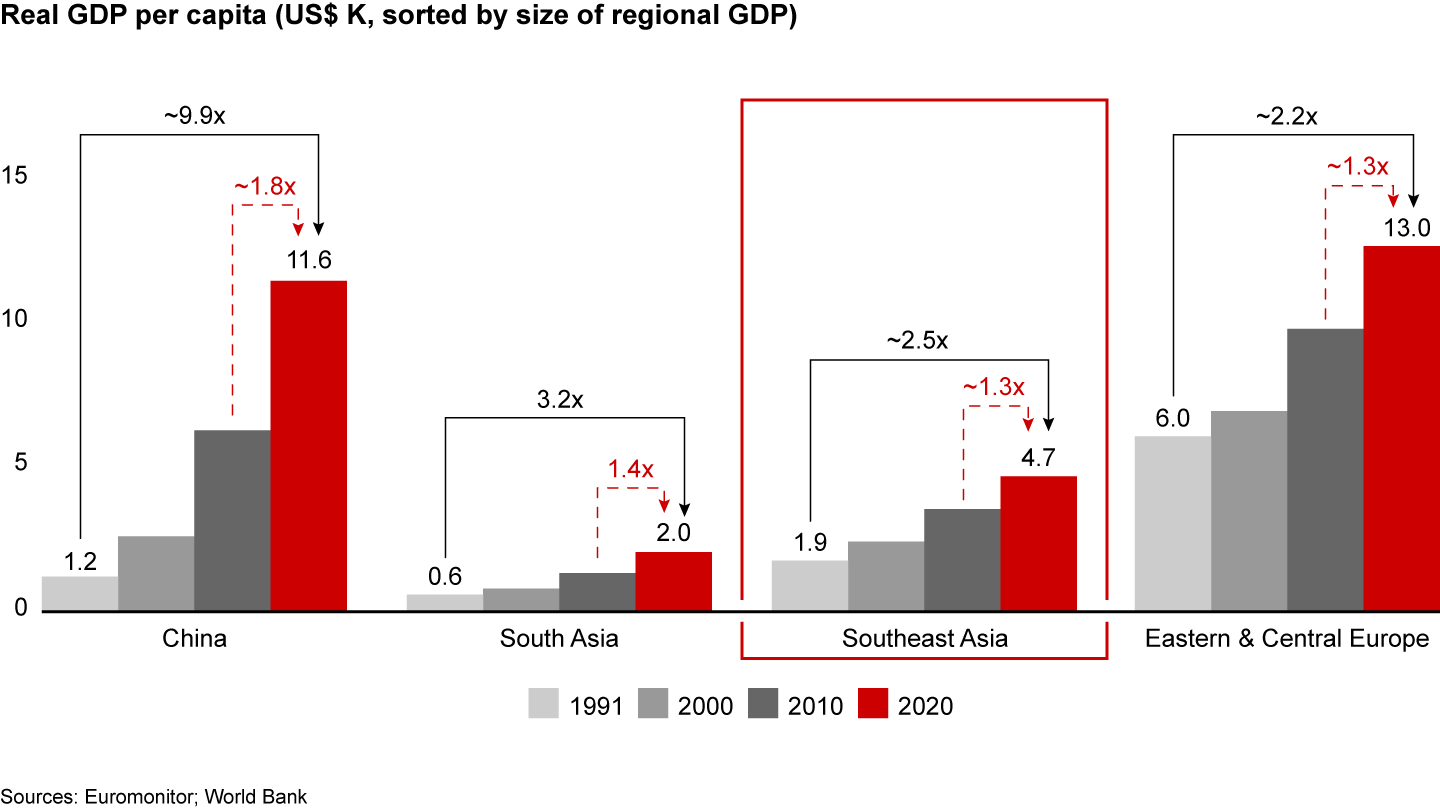

In this report, we examine ways Southeast Asia can maintain or improve on their GDP/capita trajectory and potentially regain the “emerging markets growth crown.”
Looking back at the six leading economies in Southeast Asia, we see three broad outcomes in terms of GDP per capita: Vietnam outperforming; Malaysia, Indonesia, Thailand and Singapore performing at about the same rate; and the Philippines underperforming (see Figures 2 and 3).


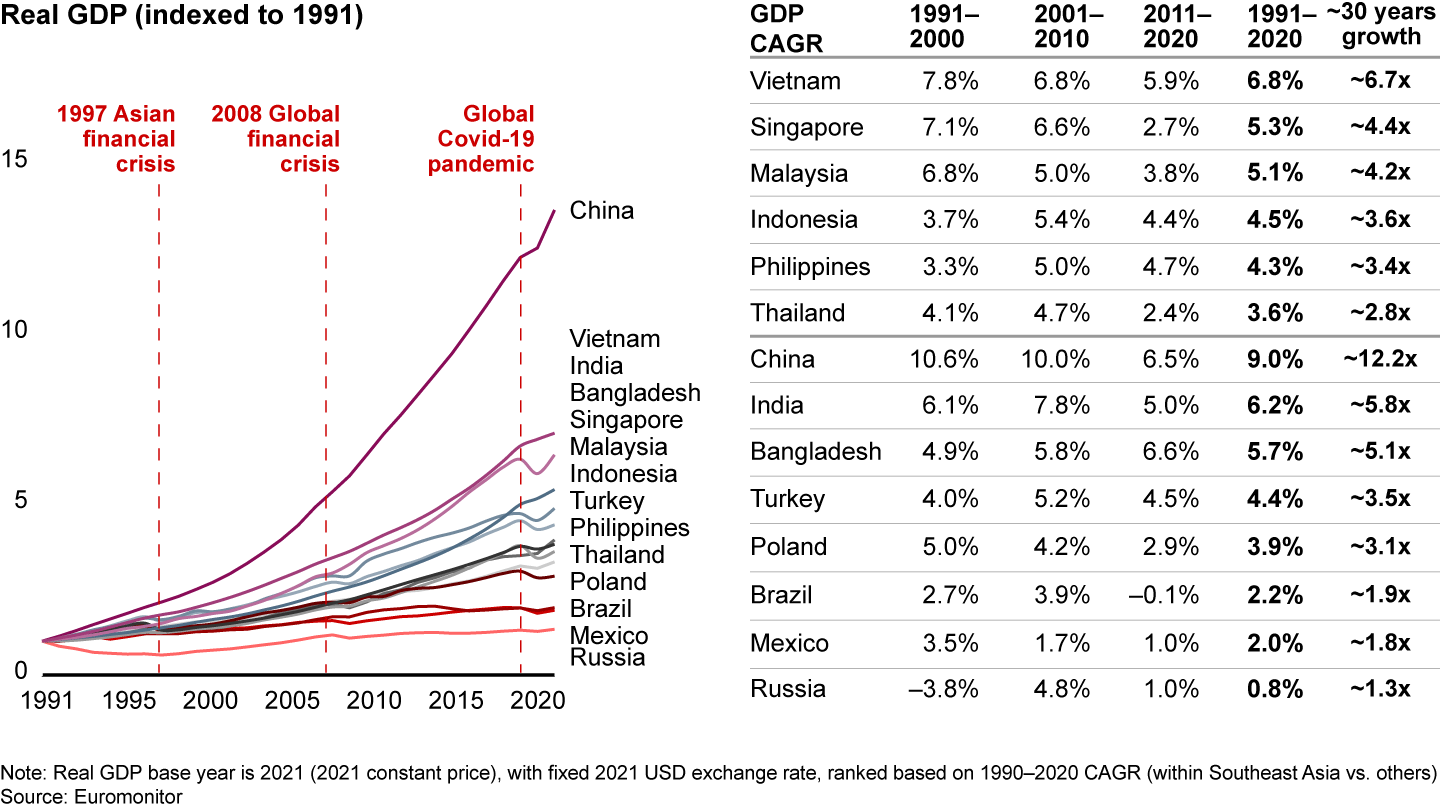

Informed by this historical data, Monk’s Hill Ventures and Bain & Company identified four questions to support strategic and financial investors evaluating portfolio allocations to Southeast Asia:
- What factors have driven Southeast Asia’s strong and steady growth over the past three decades?
- Is Southeast Asia set to improve, maintain, or decline on this growth driver?
- How have recent disruptive events (Covid-19, the war in Ukraine, global inflation) impacted Southeast Asia’s prospects?
- Within Southeast Asia, which countries will lead and which will lag?
To answer these questions, we examine four sets of growth drivers for Southeast Asia to improve on the growth rate exhibited between 1991 and 2020 (see Figure 4).
- Improving traditional development policies. Southeast Asia has demonstrated remarkable stability since fortifying its macroeconomic policies following the 1997 Asian Financial Crisis. We will refer to these policies as “traditional development policies.” Going forward, Southeast Asia, spurred by Vietnam, will make progress on a pro-growth agenda (otherwise Vietnam will win the lion’s share of the “China dividend”). In addition, the Regional Comprehensive Economic Partnership (RCEP) trade agreement will increase intra-Asian regional trade just as Western economies shift to regionalization. Finally, Southeast Asia will get a boost from Singapore’s continuing, constructive role in attracting and channeling investment and services to the region.
- Increasing impact of tech-enabled disruptors (TEDs). TEDs will directly impact investment, innovation, inclusion, and productivity growth in the 30% to 40% of the Southeast Asian economy that is amenable to digital technology, turbocharging the “traditional growth policies.” In addition, TEDs will indirectly impact both government services and the traditional sectors as they compete for employees and respond to changing citizen and customer expectations.
- Attractive demographics. Compared to China, Eastern Europe, and Latin America, Southeast Asia is in a “sweet spot” for economic expansion, marked by solid population and consumption growth.
- Offsetting geopolitical winds. Southeast Asia will be a beneficiary of the “China dividend,” which has two distinct parts. The first: As China grows, Southeast Asia grows. The second involves the “spillover” from companies shifting operations from China to other countries due to Chinese wage cost escalation, the need for supply chain diversification, East-West tension, and concerns over Chinese business policies. However, it is better to think of Southeast Asia benefitting from an “Asia dividend” as the world regionalizes and North Asia expands its position as the largest investor and trading partner with Southeast Asia.
Southeast Asia, with the exception of the Philippines, is less dependent on imported energy and food than many emerging regions, which means the impact of the Ukraine-Russia war on Southeast Asia will be lower than other “emerging regions.” Our biggest concern is the fallout from a potential conflict over Taiwan.
We believe that, when taken together, these growth drivers will result in higher relative growth than the past decade.
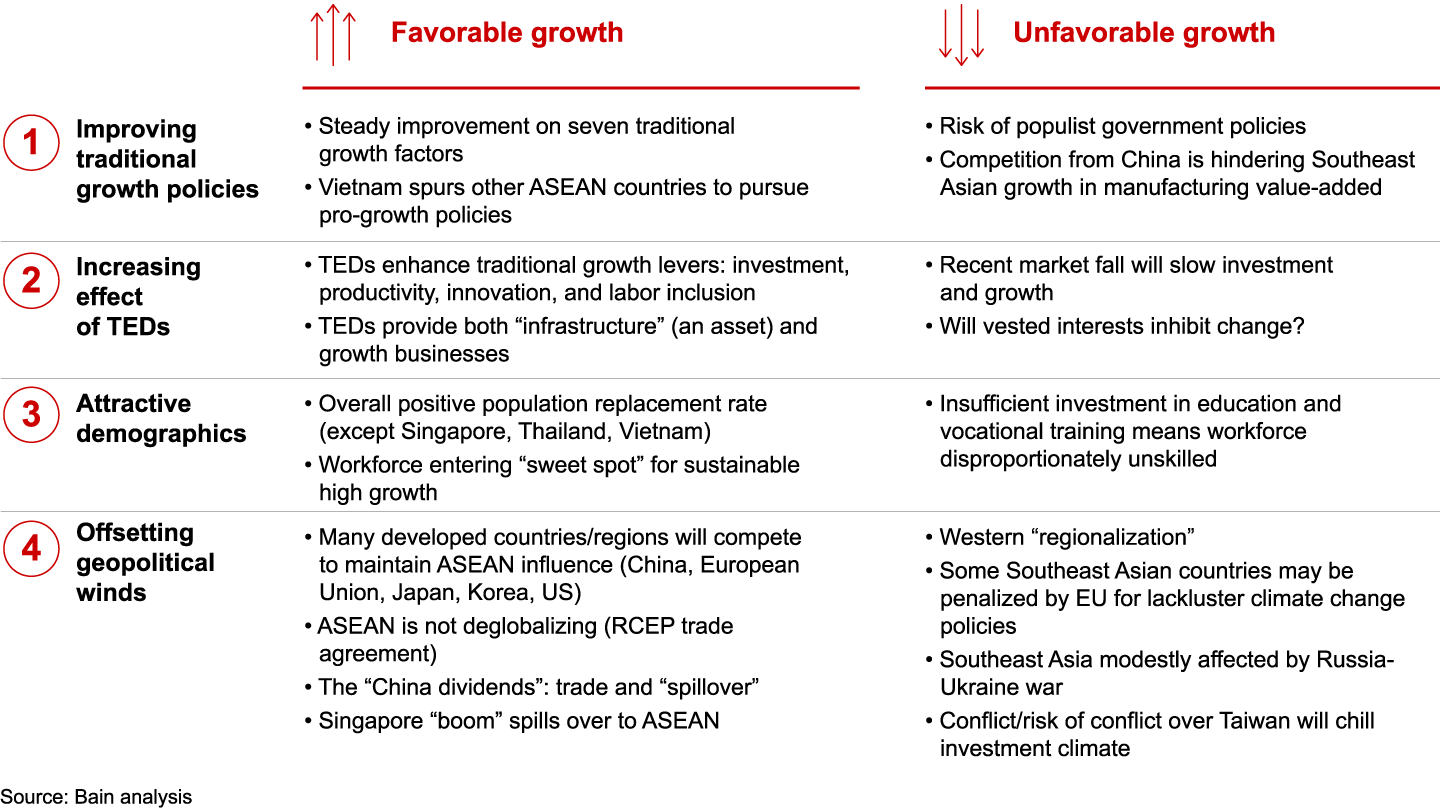

Within Southeast Asia, Bain and Monk’s Hill modeled more than 20 variables to understand growth drivers at the country level and how they might impact overall GDP per capita growth rates (see Figure 5). Given China’s outperformance in the past 30 years, we include China as a reference point to underscore our relative bullishness on Southeast Asia.
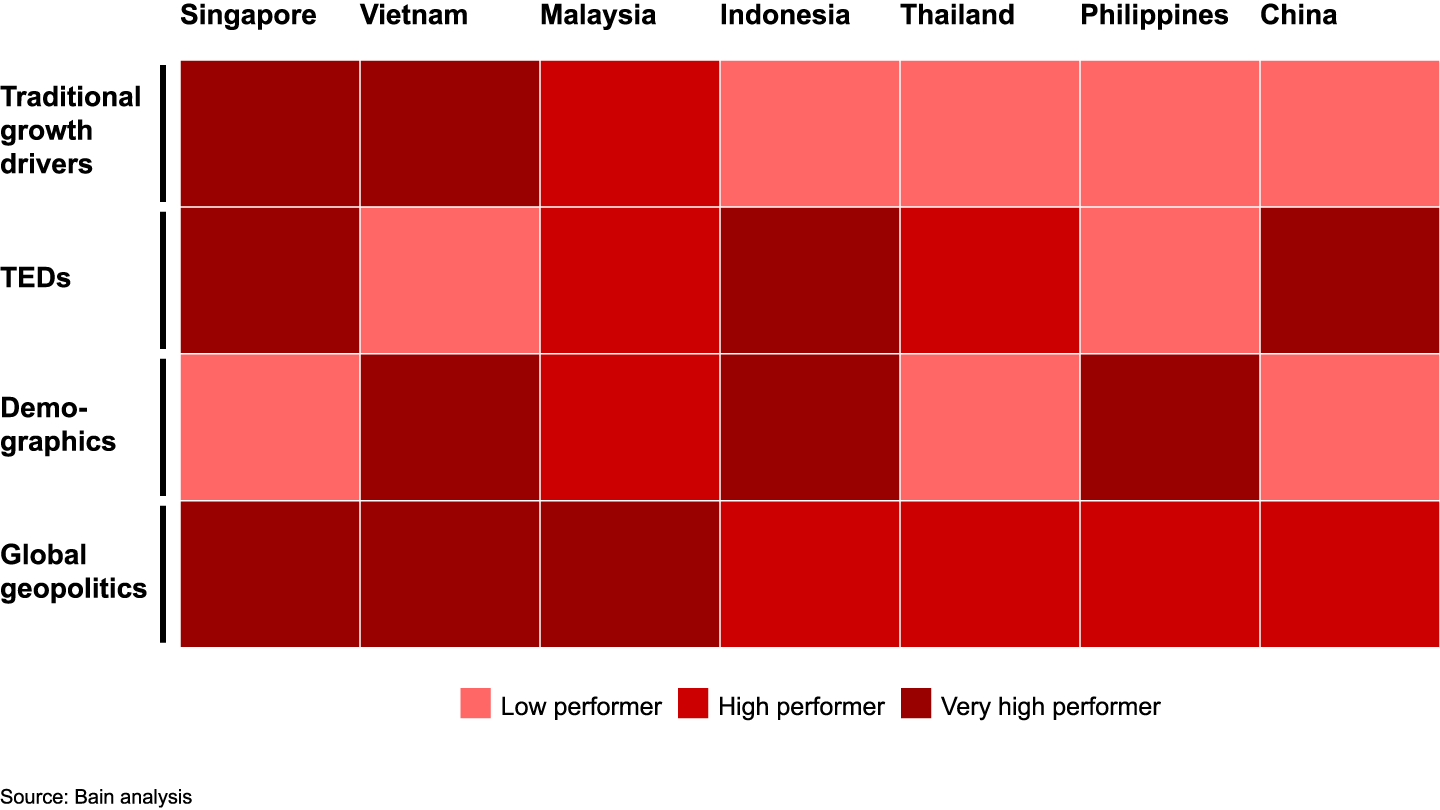

Based on the analysis in the report, we conclude with forecasts for improvements in GDP by major Southeast Asia countries (see Figure 6). Overall, Vietnam has the potential to outperform the past decade, while the rest of Southeast Asia is able to maintain or slightly exceed 2010 to 2021 growth rates (with Thailand our main concern). Given the likely slower growth in China and the Organization for Economic Co-operation and Development (OECD) countries, we believe this is a positive outcome for the region.
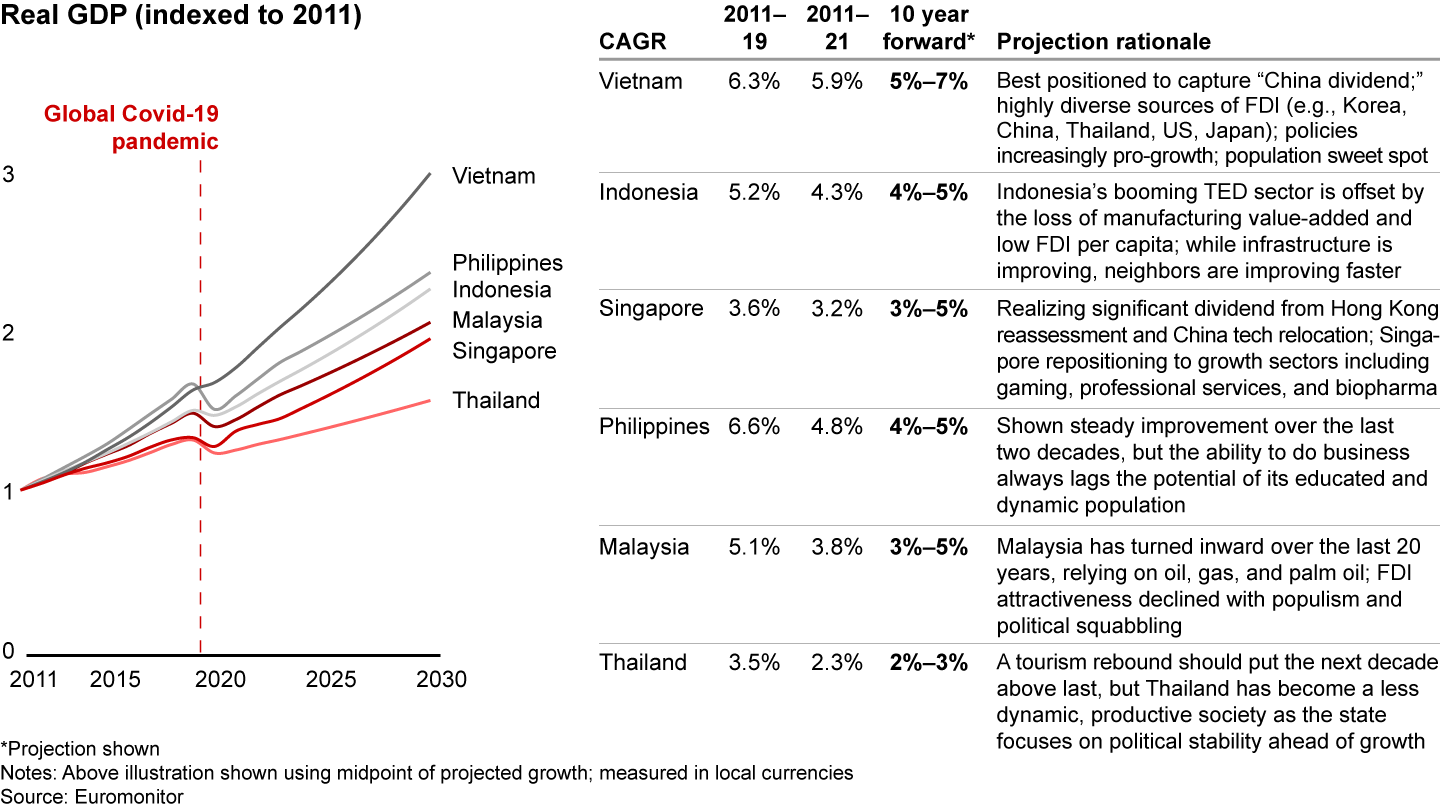

Growth driver #1: Improving traditional growth policies
To understand historical Southeast Asia performance, we distilled the vast research on what economists, businesses, and financial investors generally consider the traditional drivers of growth in developing economies into seven factors (see Figure 7). These are highly influenced by government action (or inaction).
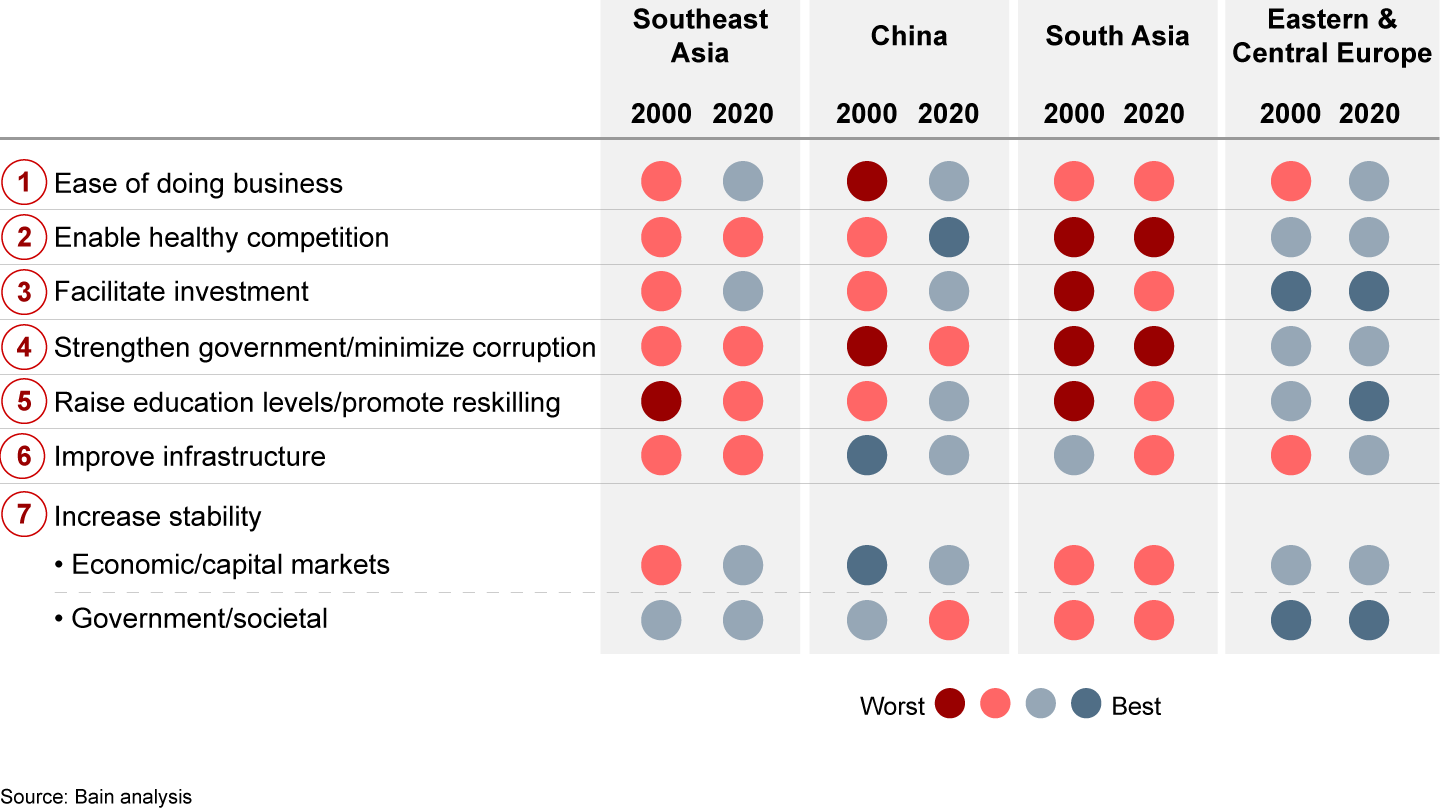

Ease of doing business
Southeast Asia has made steady progress in improving the ease of doing business. This includes the process of starting a business, getting credit, and resolving insolvency (see Figure 8). Were we to select or weigh factors differently, the answers would shift only modestly; the picture corresponds with our experience with both start-ups and multinational corporation (MNC) investment in the region.
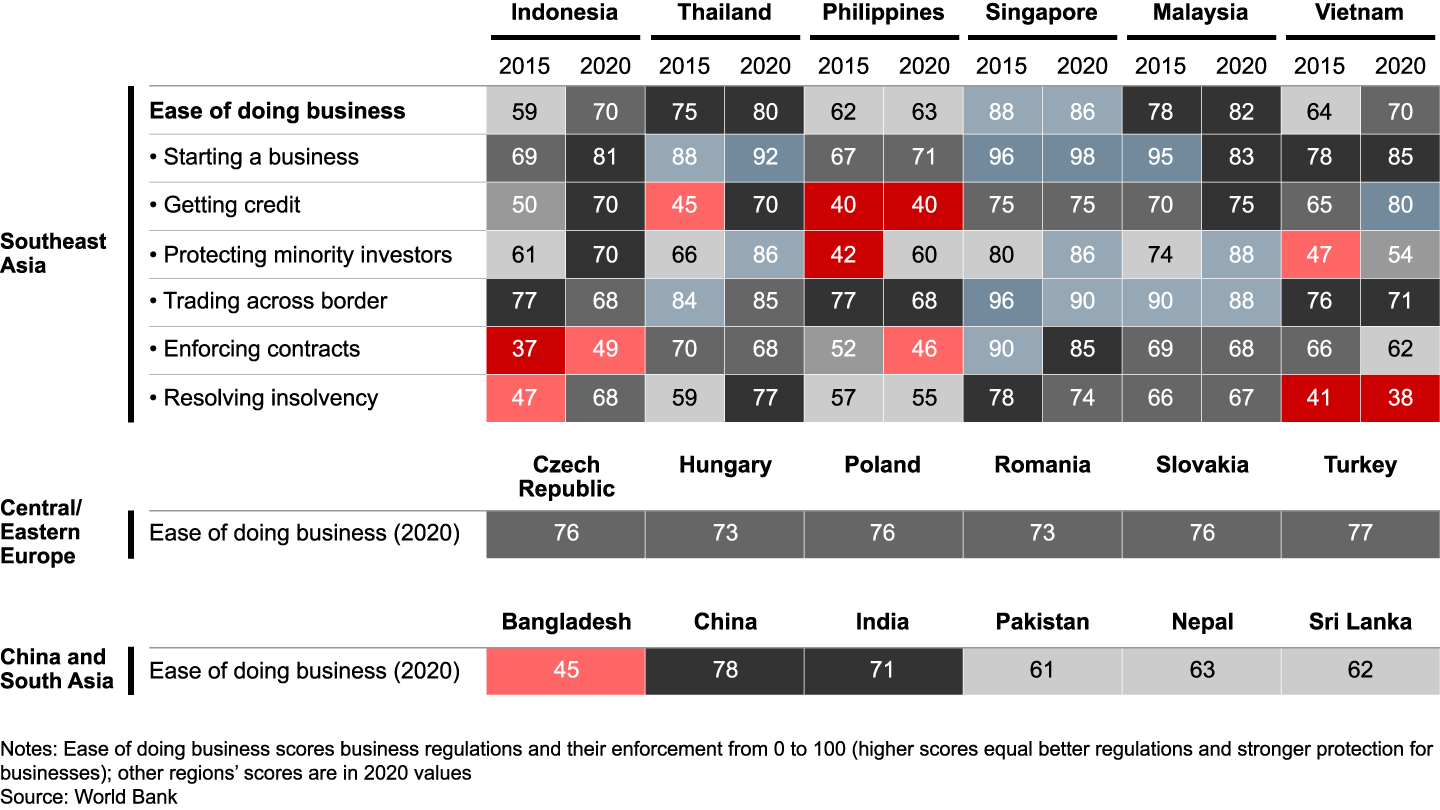

One of the challenges of this data is that the experience of an MNC may vary significantly from that of a domestic player. In addition, there can be important differences by sector within a country. For example, foreign investors in a large mining operation in Indonesia may have a very different experience from a small or medium-sized Singaporean enterprise setting up a trading operation in Surabaya; the MNC experience in financial services in Singapore is different from the MNC experience in petroleum refining or semiconductors; and corruption in the palm oil sector may be very different from corruption in the banking sector. In general, MNCs participating in export sectors have an easier ride than those competing for the local market.
World Bank data suggests that, within Southeast Asia, Indonesia and Vietnam have experienced the strongest improvement in the past 5 years, and our experience supports that. Thailand, Malaysia and Singapore continue to perform well against benchmarks, but gaps remain on key issues like enforcement of contracts. In short: good enough but not exceptional.
Enable healthy competition
Traditional approaches to stimulating growth in developing markets looked to large local players that would compete both locally and globally. These “national champions” generally were protected from foreign competition in the local market. This approach was a successful growth model in the early to middle stages of development for Japan, Korea, and Taiwan and is now being followed by China. However, even for successful economies there were consequences in terms of less developed capital markets, a less innovative small/medium business base and inefficient services sectors.
In much of the world, the choice to protect national champions within the domestic market for extended periods resulted in corporate bloat, unproductive diversification, and rent seeking. Many erstwhile industrial groups derive a significant share of profits from real estate and government contracts. These groups crowded out or directly suppressed entrepreneurial activity as they took advantage of preferential access to talent, capital, and government policymaking.
We believe the national champion approach to growth is a spent force; the key growth driver going forward will be the TEDs. To take full advantage of this “revolution,” governments need to embrace fostering local venture capital and other small business financing, enabling talent-hopping, reducing the consequences of failed business ventures, and lowering barriers to entry and competition with established players. The good news is that Southeast Asian governments have made significant and positive steps over the past 20 years in this direction; a review of business registrations in the last 8 years provides indirect evidence of the improvement in entrepreneurism in several SE Asian countries (see Figure 9). Advancements in the airline, retail, financial services, and logistics sector underscore the level of government policy support for TEDs.
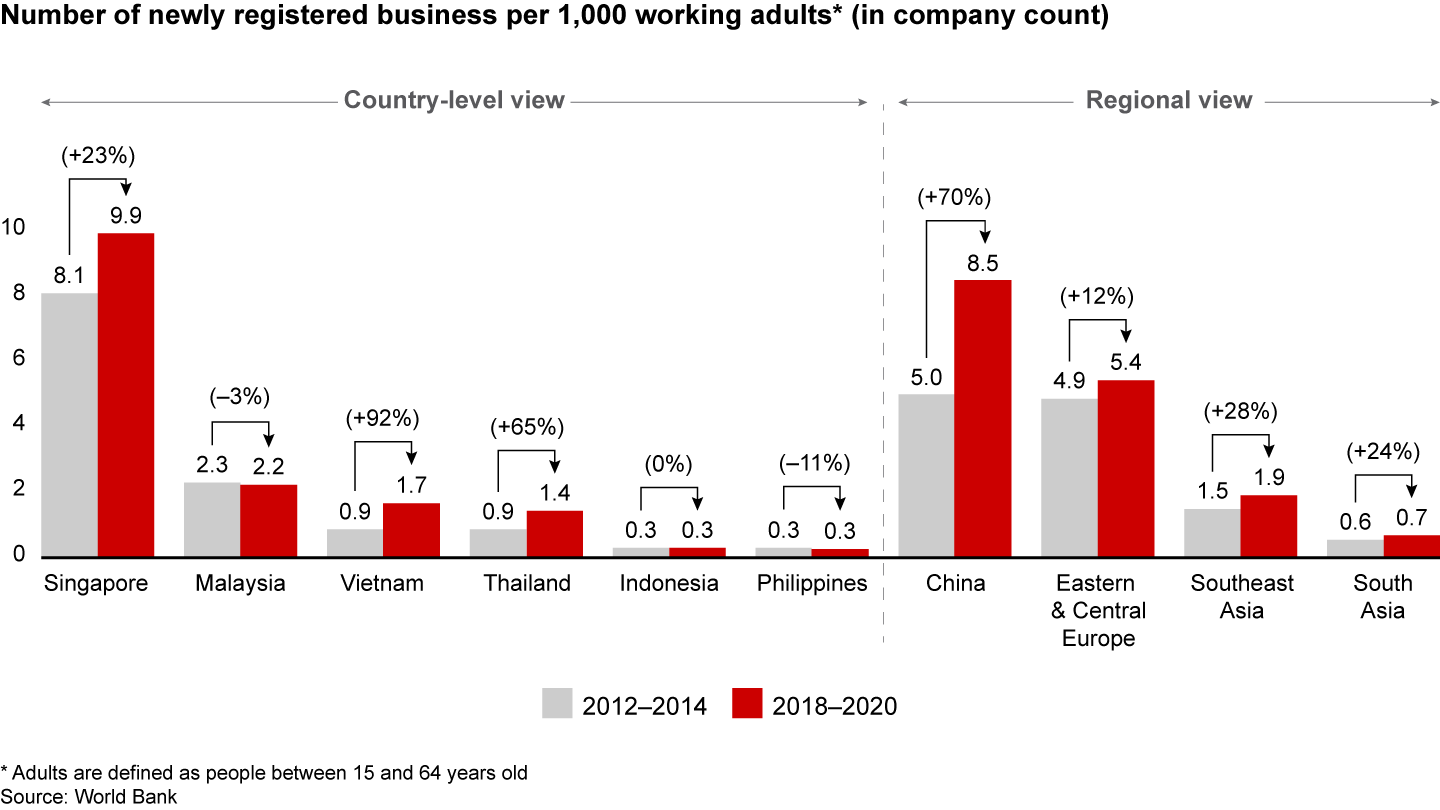

Facilitate investment, both domestic and foreign
Southeast Asia has some of the world’s highest savings rates. It is important, therefore, to look at both domestic and foreign sources of investment. While Southeast Asia and South Asia have grown investment nearly 60% and 50%, respectively, in the past 10 years, China grew investment 120%. Foreign direct investment (FDI) is also a larger share of investment in Southeast Asia than other regions (see Figure 10).
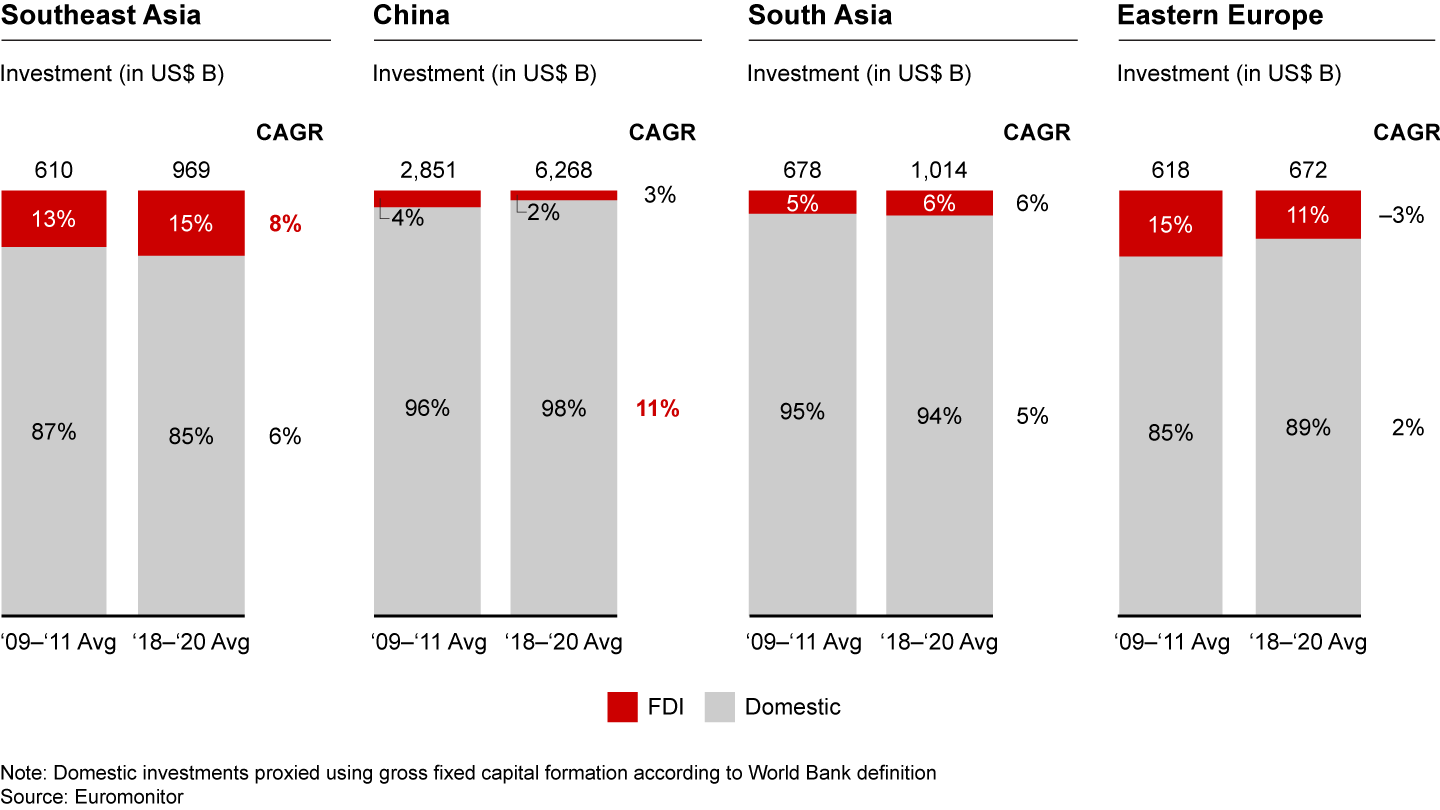

Digging below the regional average, however, changes the picture. Exclude Singapore, and FDI per capita falls below China and Central and Eastern Europe (see Figure 11). Our concern is that the strategic value of FDI is greater than the monetary value, as FDI is often accompanied by technology and expertise transfer, increased competition, improved productivity growth, and the multiplier effect on supplier clusters. Southeast Asia would benefit from further liberalizing FDI in prioritized sectors.
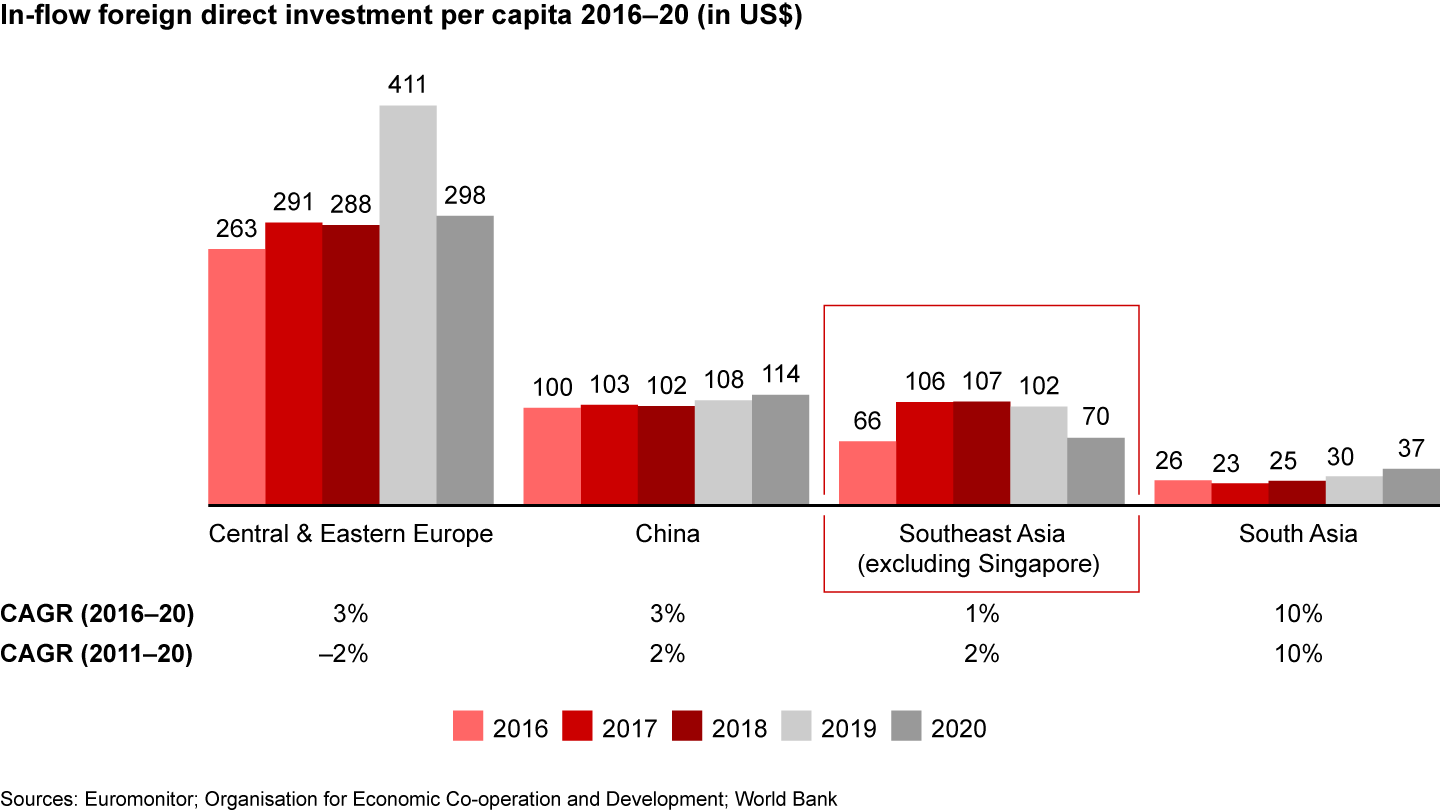

Strengthen government effectiveness and minimize corruption
The World Bank provides a range of measures to assess government effectiveness, which generally corresponds with our experience (see Figure 12).
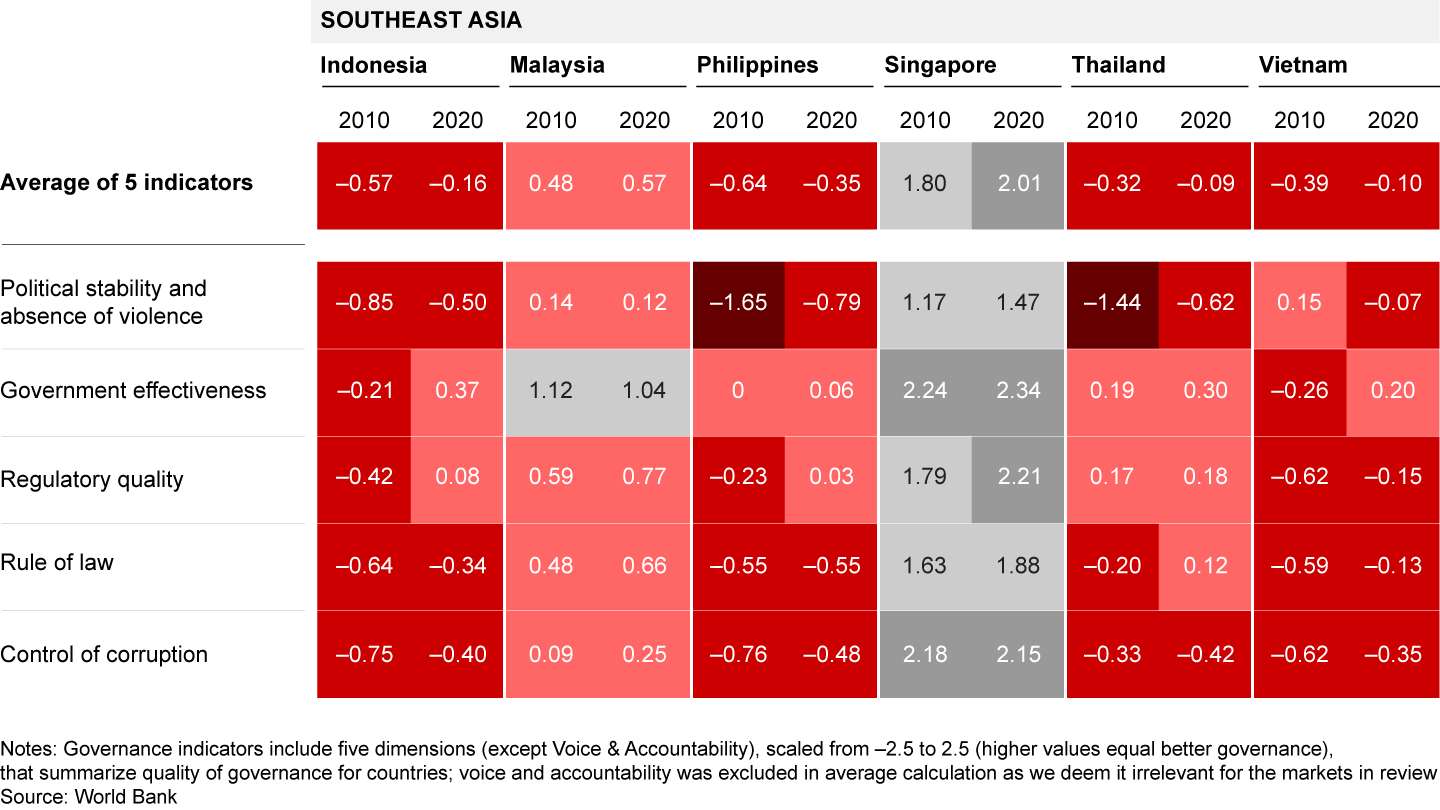

Most countries have seen steady improvement in each measure, but only Singapore stands out. Malaysia’s 1MDB scandal has generated the most attention worldwide, but in general, the rules are clearer in Malaysia, and its court system is more reliable than in other Southeast Asia countries except Singapore.
Raise education levels and promote re-skilling
Except for Singapore and Vietnam, most of Southeast Asia has failed to improve education levels in both the general population and for technically demanding vocations. According to OECD’s Programme for International Student Assessment (PISA), Singapore’s score is outstanding while Vietnam, which is ahead of the US, approaches the level of more developed countries such as Japan, Korea, and China (see Figure 13). Other countries in Southeast Asia are well below desirable levels.


Southeast Asian governments should recognize that they will never attract the highest value-added sectors if 40% of the world’s population (Europe, US, Japan, China, Korea) reside in countries with much higher levels of education.
While PISA measures achievement of reading, math, and science standards for 15-year-olds, we turn to the Global Talent Competitiveness Index (GTCI) to understand how workforce skills are evolving. A similar picture emerges: Singapore stands out, while other Southeast Asia countries show modest performance (see Figure 14). In this chart Vietnam falls at the lower end of Southeast Asia, probably reflecting the time it will take to get the benefit across the full population of market liberalization and investments in education.
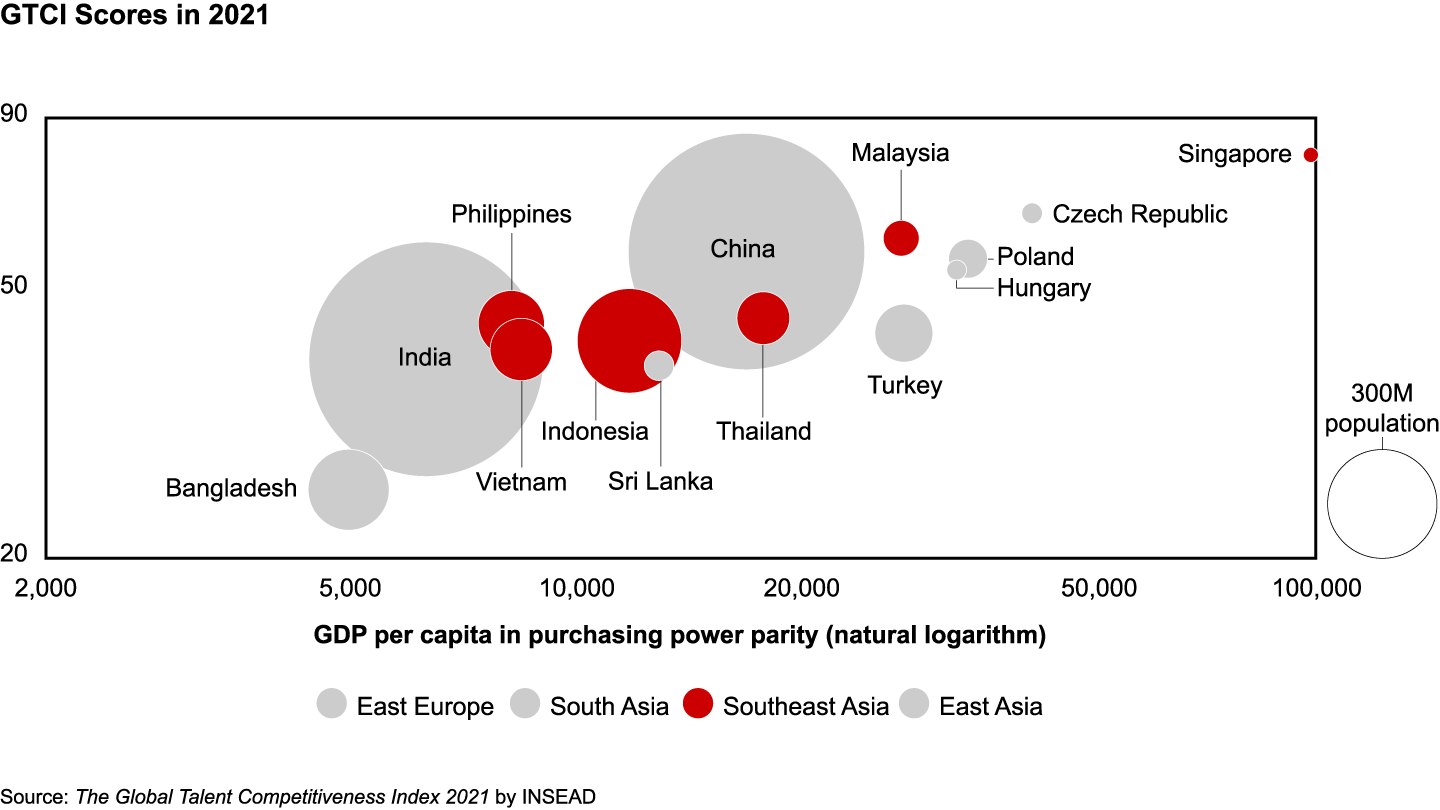

Improve infrastructure
Governments have traditionally played a critical role in infrastructure through land rights, pricing, and regulatory policies as well as the need for long-term financing and highly integrated civil engineering. Airports, roads, seaports, rail lines, high-speed rail, water, drainage, sewage, electricity, telephony and broadband, natural gas, petroleum pipelines and storage, and urban public transport: All are critical to a modern economy.
During the past decade, we have seen increased attention paid to digital infrastructure, including broadband capacity and speeds, cybersecurity, secure digital national identities, and digital government services. Southeast Asia has lagged China spend levels (see Figure 15) and it would appear to lag China in the quality and impact of that spend as well.


Increase stability
Southeast Asia has steadily improved its financial and economic stability since the 1997 Asian financial crisis, particularly in important matters such as managing inflation and defending the values of currencies (see Figures 16 and 17). As expected from a region with a high current-account surplus, Southeast Asia boasts high levels of foreign currency reserves relative to GDP. This macro prudence has yielded a very low rate of sovereign debt defaults.
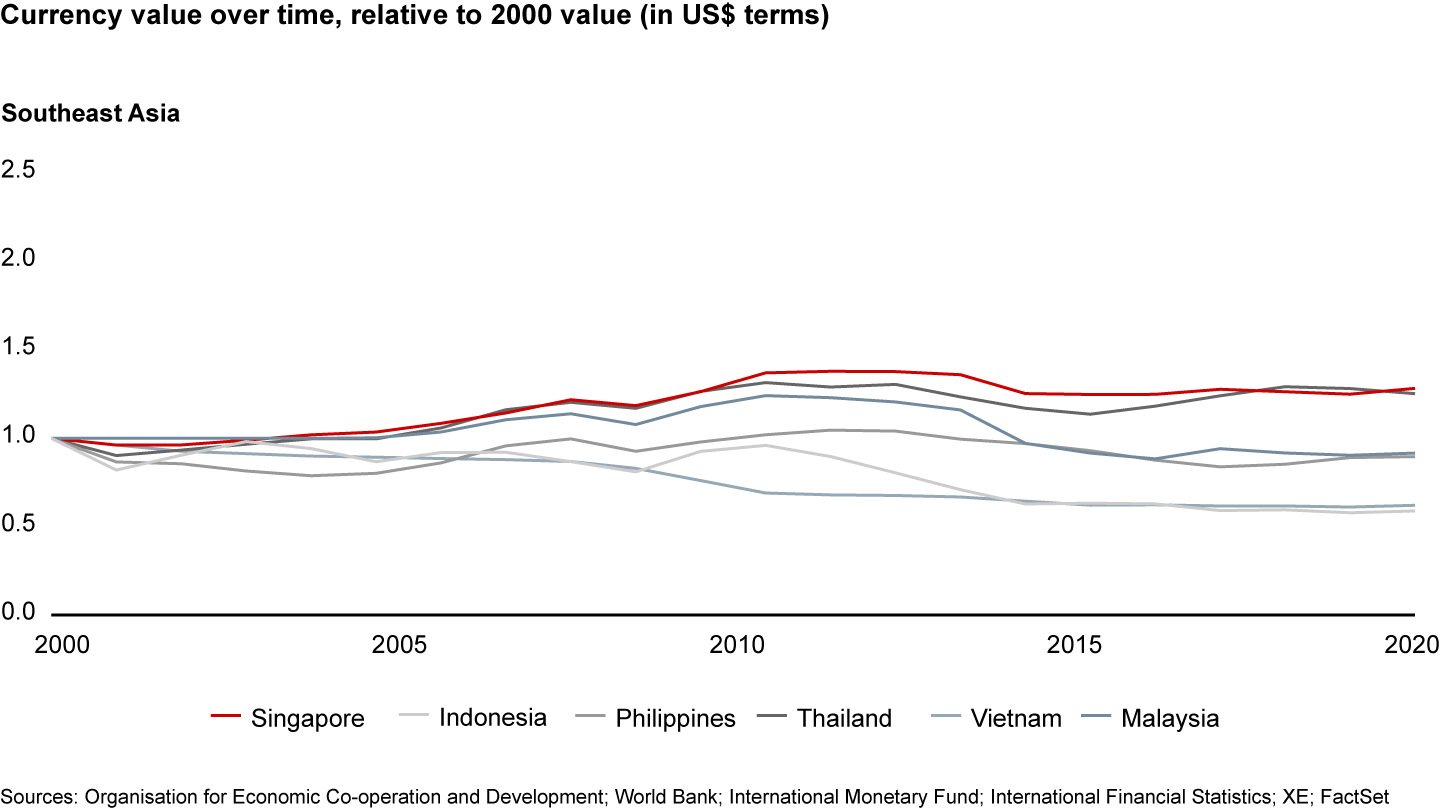



Good stewardship also makes it easier for Southeast Asian companies and governments to attract global capital (see Figure 18). Compared with other emerging-market blocs, Southeast Asia offers highly rated, investment-grade issuers (see Figure 19).
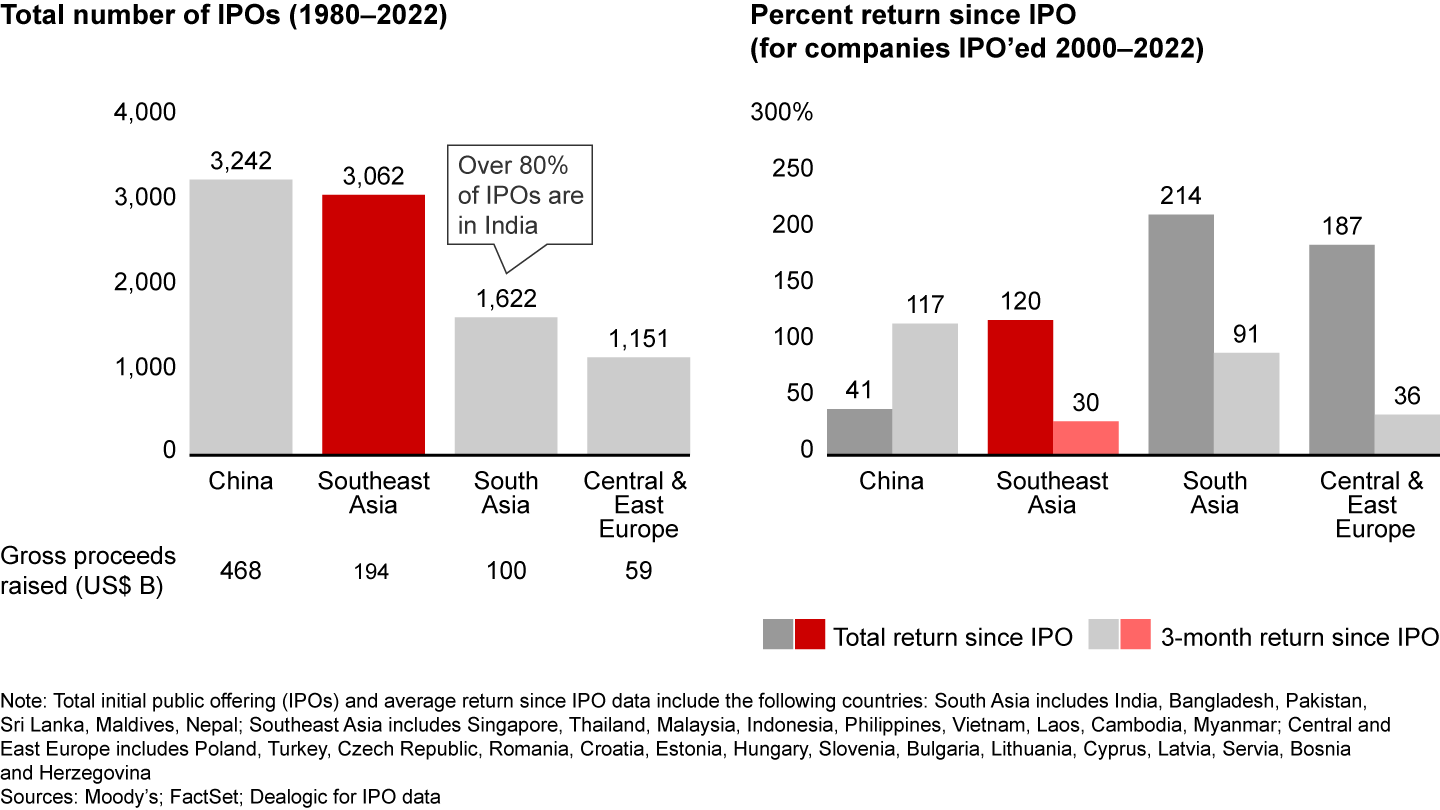

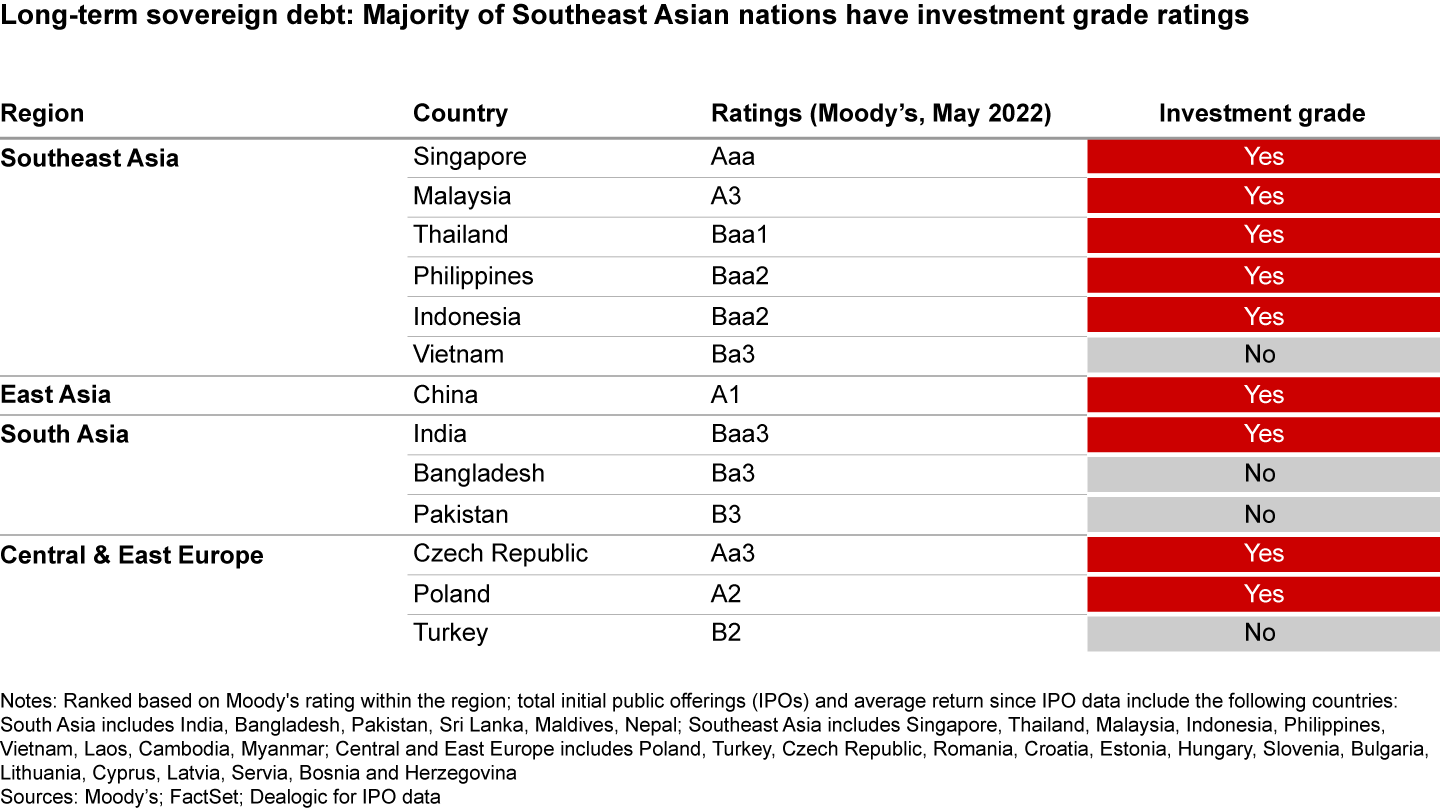

Total Factor Productivity (TFP) is the idea that growth can come from either more labor or capital, or it can come from more productive labor and capital. Although initially counter-intuitive given China’s high growth rates, a number of studies have shown that China’s TFP levels are low. The country’s high growth rates have partly been a function of improving labor productivity (from a low base) and we expect this to continue as China automates existing sectors and expands into higher value added sectors. In addition, the high growth rates have been a function of a significant “demographic dividend” that is now reversing, directing extraordinary levels of GNP into investment vs. allowing it to be used for consumption (in other words, 30 years of delayed gratification) that is no longer sustainable and increasing worker hours. As a result, we do not expect China to grow at historical rates, offering an opportunity to Southeast Asia to close the gap or even exceed China's growth.
In comparison, Southeast Asia has relatively good TFP but would benefit from higher investment rates (see Figure 20).
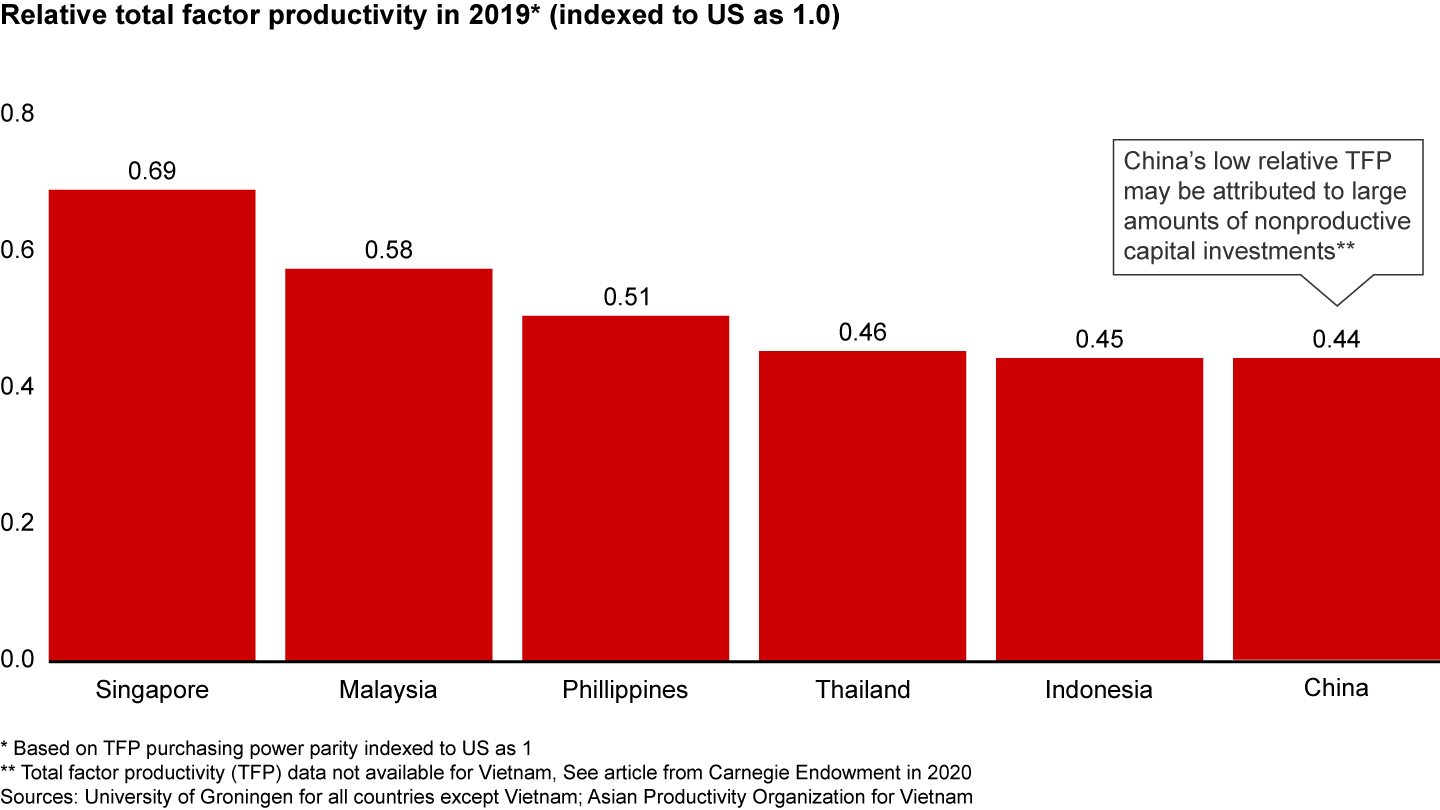

Looking forward, we believe Vietnam is now setting the pace for improving the ease of doing business and other traditional growth drivers in the market. Following China’s lead, Vietnam is facilitating investments in export-oriented sectors and domestic infrastructure (e.g., offshore electricity generation and distribution). Interestingly, the four largest foreign investors in Vietnam are Asian: Singapore, Japan, China, and Korea. Furthermore, Vietnam is selling off state-owned enterprises and reducing import tariffs, and has pursued stable, cool-headed international relations.
We believe the net impact will be that the slow and steady pace of liberalization of the Philippines, Thailand, Indonesia, and Malaysia may be boosted by the fear of missing out to Vietnam over the next decade.
Growth driver #2: The impact of TEDs
Today, technology-enabled disruptors (TEDs) are the greatest force of progress in most developing countries. TEDs are directly and indirectly impacting six of the seven Bain/Monk’s Hill traditional growth drivers by promoting business creation, enabling healthy competition, raising investment, strengthening e-government, improving education and productivity levels, and improving infrastructure.
Actual or threatened pressure from TEDs is forcing traditional family-controlled or state-sponsored national champions to increase investment levels and accelerate innovation or face irrelevance in the coming decade. Given the digital nature of these businesses, we see TEDs breaching traditional country barriers to pursue regional or multiregional business opportunities with only minor adjustments to their business model.
To illustrate the impact of TEDs on growth in Southeast Asia, we focus on four sectors: airlines, fintech, logistics, and super-apps/platform businesses. These examples are meant to highlight just how significant the disruption has been to “traditional” sectors and how this disruption will raise growth rates in Southeast Asia (see Figure 21).
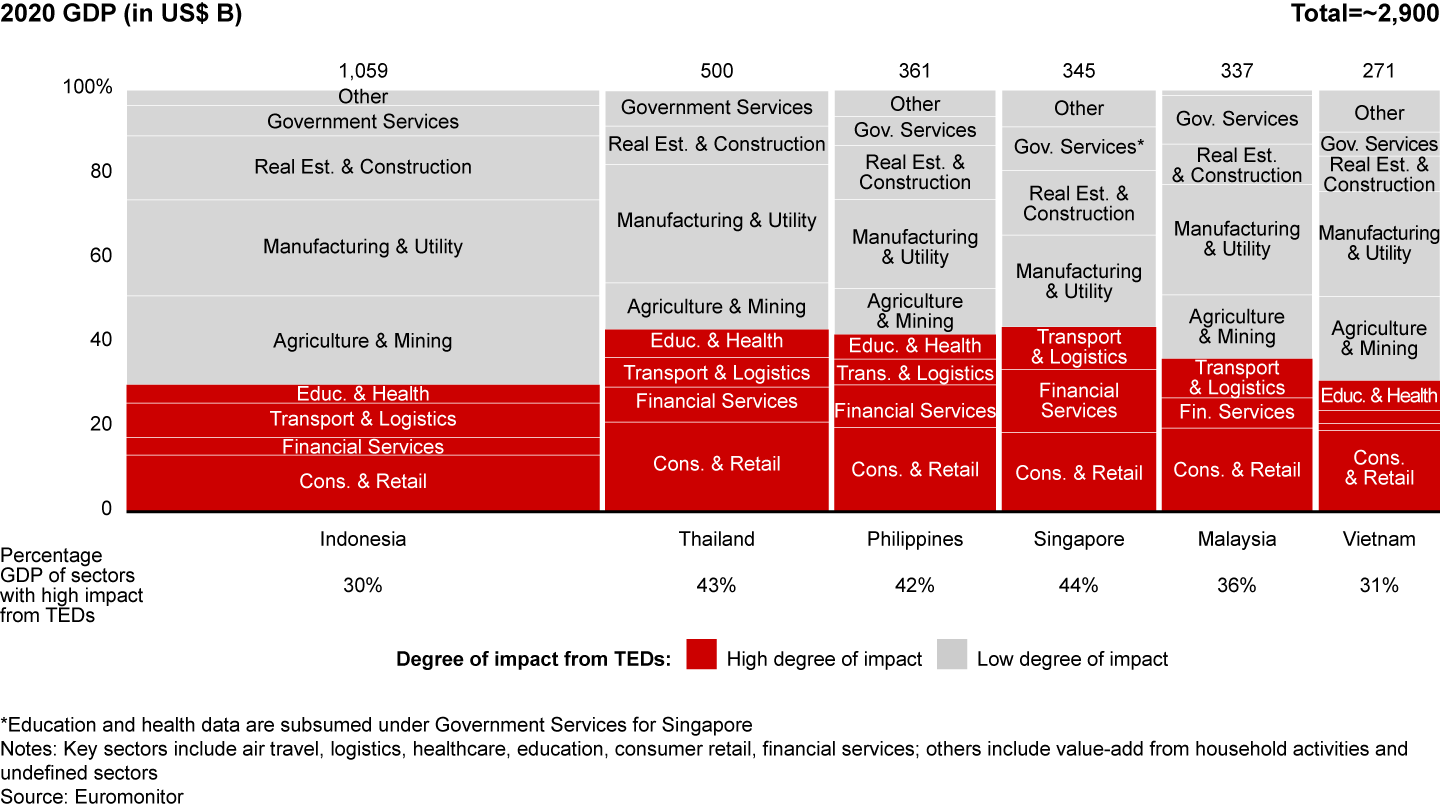

It is important to note that TEDs are not succeeding despite government; governments have modified policies and regulations and promoted infrastructure building in areas critical to TEDs. Due to TEDs’ domestic “pedigrees,” we anticipate this support will continue.
Case study 1: Aviation
The rapid growth and ultimate success of AirAsia following its 2001 launch disrupted the legacy air travel market. The low-cost carrier business model lowered average fares and stimulated new waves of domestic and cross-border travel. Such a direct threat against a state-owned incumbent airline might not have been tolerated amid the crony capitalism of pre-1997 crisis Southeast Asia.
AirAsia was soon joined by other low-cost carriers (LCCs) in Singapore (Tigerair/Scoot, Jetstar Asia), Thailand (Thai AirAsia), Indonesia (Lion Air, Indonesia AirAsia), the Philippines (Cebu Pacific, Zest), Malaysia (Firefly and Malindo), and Vietnam (VietJet Air, Jetstar Pacific). It is possible that incumbents and regulators did not appreciate the power of LCCs, thinking it was safe to leave the low-income segment of society to no-frill carriers.
Within 15 years, virtually every major country “flag carrier” (Thai Airways, Malaysian Airlines, Garuda Airlines, Philippines Airlines, Vietnam Airlines), generally with significant state backing, was forced to restructure.
The arrival of LCCs played a decisive role in the need to restructure flagship carriers. Low prices were just one aspect of their challenge. LCCs also were early to incorporate new technology to improve their cost advantage (see Figure 22). This technology included websites and apps to sell tickets (and add-ons) directly, artificial intelligence (AI) for optimizing operations, streamlined check-in procedures, and fast aircraft turnarounds.
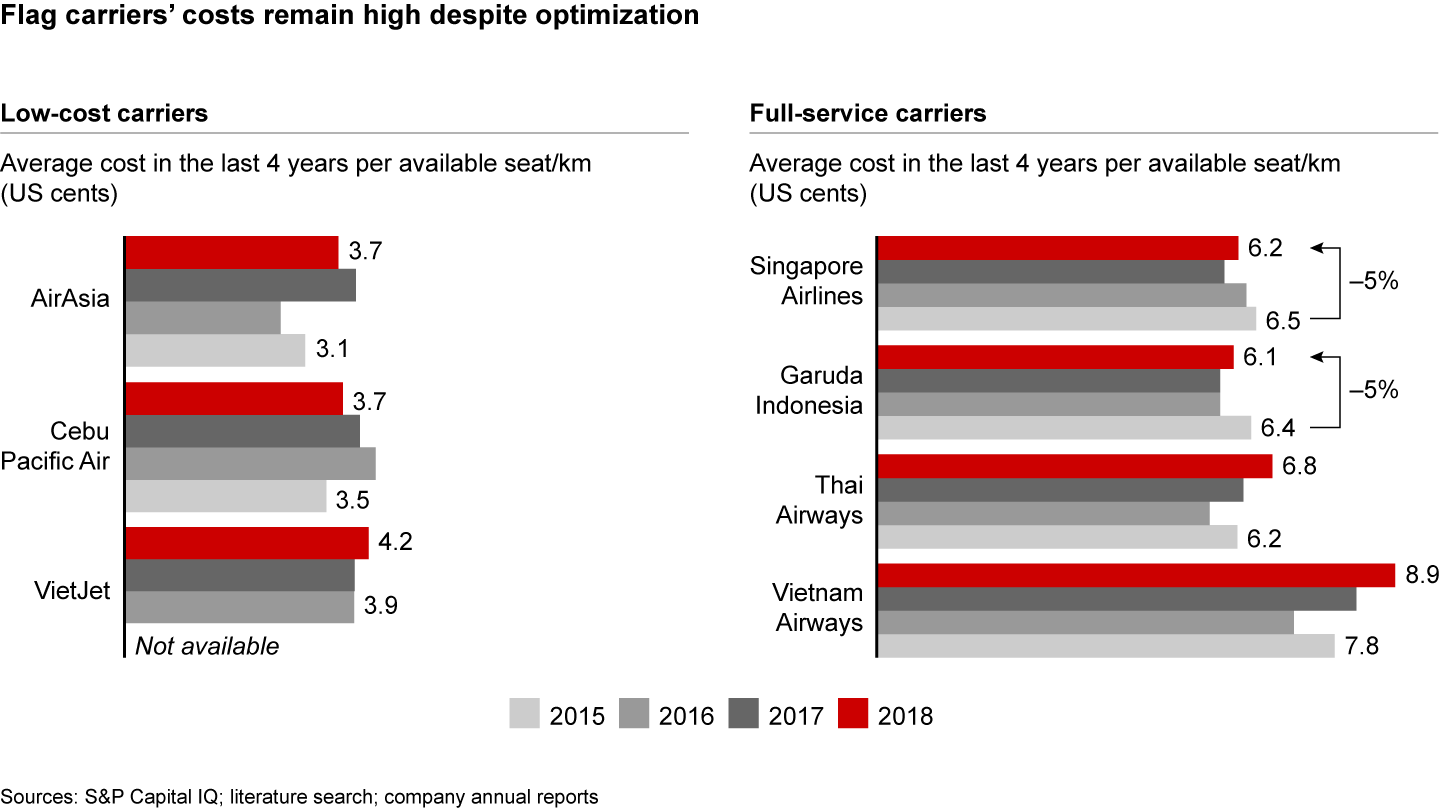

Incumbents continue to lag the low-cost, highly innovative LCCs. The result: LCCs grew their traveler numbers at more than twice the rate of flagship carriers and by 2019 accounted for 60% of regional passengers (see Figure 23).
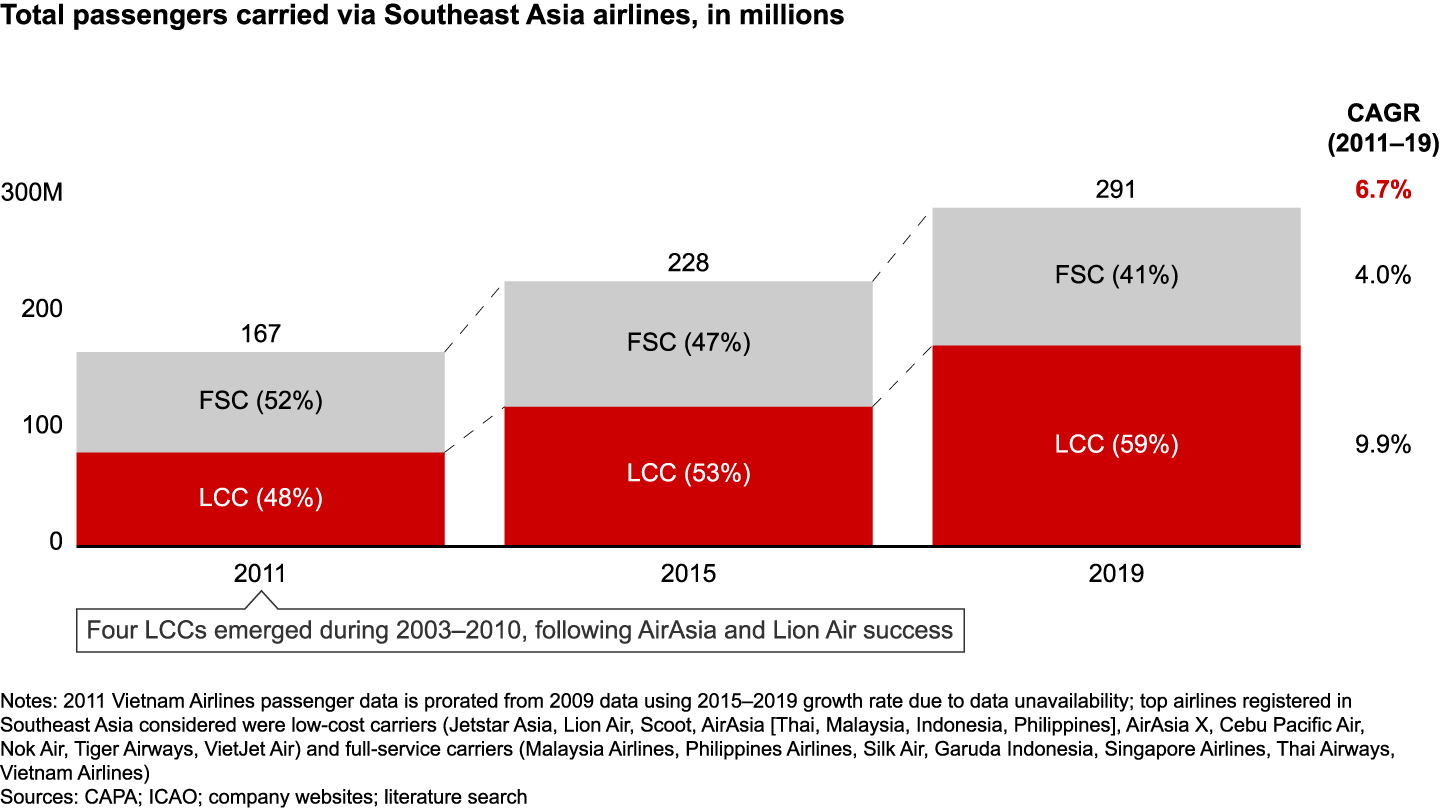

Despite the impact on formerly protected national airlines, ASEAN signed the ASEAN Open Skies Agreement which came into effect in 2015 and further facilitated the growth of the LCC sector. We admire the ASEAN commitment to realizing the benefits of airline competition on tourism, labor mobility, and overall efficiency while accepting the consequences of competition on previously protected flag carriers. A better-connected region has had even more powerful effects on adjacent industries such as logistics, exports, and hospitality sectors, from gaming in Singapore to healthcare in Bangkok.
Case study 2: Finance
In finance, Southeast Asia is at an earlier stage in digital disruption, but broad and exciting trends are clear.
There are three categories of players battling in the fintech revolution in Southeast Asia:
- “platform players” like Grab, GoTo, Alibaba, and Sea Group, which are leveraging their super-apps and strong position in various digital services to build fintech businesses;
- start-ups finding niches based on cost advantage, service advantage, or simply reaching customers that have never participated in the formal banking or insurance sector; and
- incumbent financial institutions that are embracing digital opportunities for both offense and defense.
Fintech is attracting the largest share of venture capital in the region, more than two times the e-commerce sector (see Figure 24).
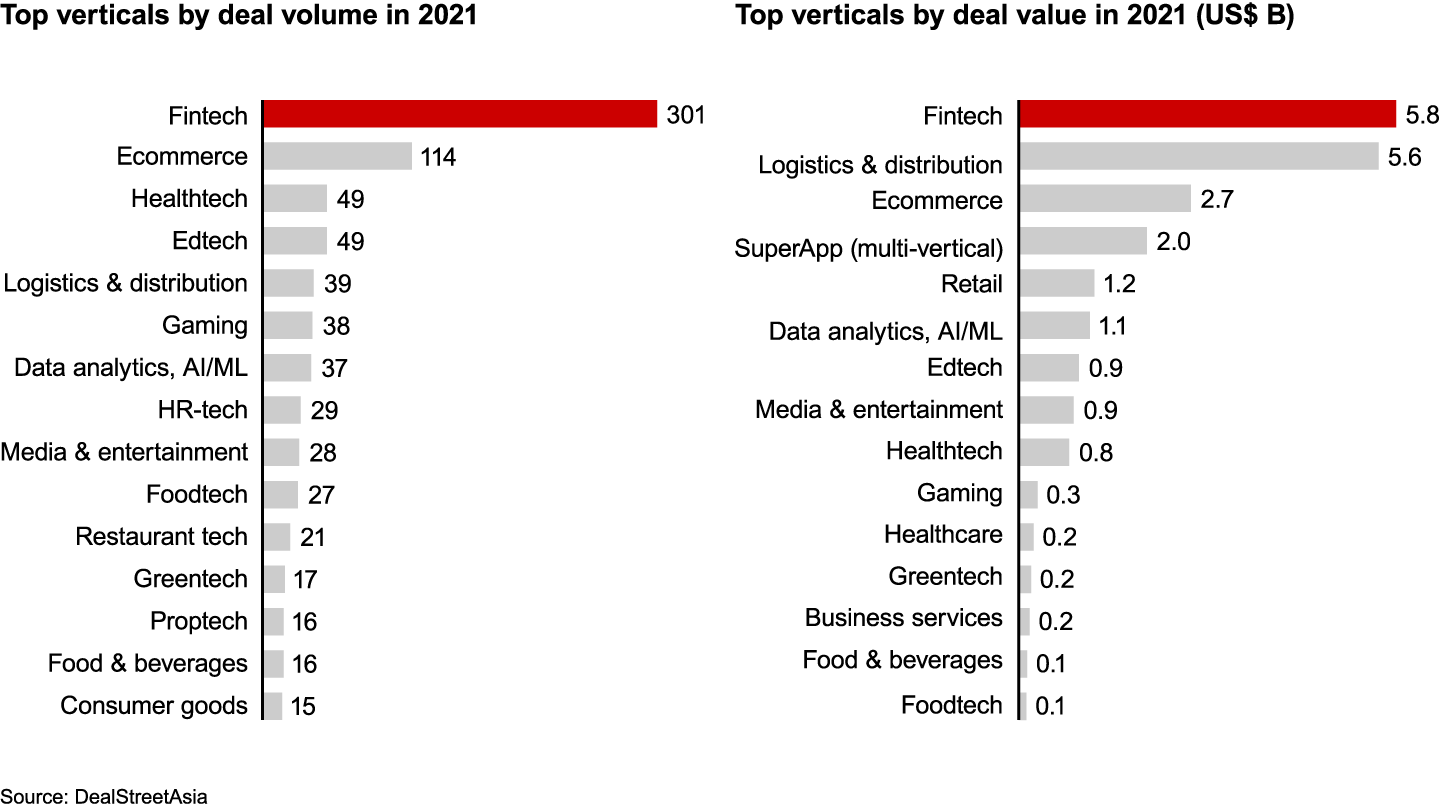

While there are many ways to divide the fintech market, at the highest level we think of four broad subsectors: payment, lending, wealth management, and insurance (see Figure 25). In all four, Southeast Asia is well behind markets in both the US and China, but we see this as only an indication of the growth potential in the next 10 years.


A digital economy requires digital payments. In the early days of e-commerce, most services targeted the affluent, banked population segments. As low-cost, fast, QR-code-enabled options proliferated, previously unbanked individuals and small business owners with no access to credit or debit cards could participate in the new industries. Millions of citizens took their first steps toward online transactions and never looked back.
With lending, activity is progressing across a broad front, from simplifying approval processes for established products with existing borrowers to dramatically expanding the reach and scope of receivables finance; “micro-finance”; salary advances; and small-scale, asset-backed lending (e.g., for a motorcycle or tuk-tuk).
Regional banks, led by DBS of Singapore, are responding aggressively to the challenge of digital banking, increasing innovation and lowering the cost of services to customers. Their efforts range from shifting services with established customers to digital interfaces and processes, to establishing new digital banking businesses in India, Hong Kong, and Indonesia.
E-commerce giants such as Grab and Sea Group have obtained digital banking licenses in Singapore. As they leverage their super-apps, broad customer reach, and digital-native-technology platforms, competition is likely to be ferocious, with the major platform players clashing with established banks that are moving fast to face the challenge.
Singapore’s government is taking the lead, both regionally and globally, in promoting blockchain-based means of payment and securities settlement in a regulated fashion. Over time, this will spur the digital economy. But headline-grabbing next-generation projects like blockchain aren’t required for fintech to knit Southeast Asia together. Simpler measures such as integrating domestic payments systems via humble QR codes will have a meaningful impact.
In July 2022, five Southeast Asian central banks announced they will allow travelers from among their nations to pay for local goods and services by scanning QR codes. Such payments will use local currencies instead of the US dollar as an intermediary, cutting costs for users and boosting the role of Asian currencies within regional commerce.
Regulators are aware that disruption caused by fintech may create challenges. Fintech brings dangers, such as the risk of predatory lending practices, gambling-like “investment” platforms, and crypto-related scams. Enormous issues around privacy, money laundering, criminal activity, and the like will no doubt keep regulators busy. But if fintech is properly regulated, the benefits of greater inclusion, better services, lower costs and enabling the growth of other businesses will pay off in higher economic growth.
Case study 3: Third-party logistics
Southeast Asia’s geography—its mountains, islands and seas—creates inherent challenges to building the physical infrastructure needed for economic activity. LCCs are knitting the region by air, and wireless communication is enabling e-commerce and digital payments. In response, massive investments in logistics are rapidly closing the gap for “last-mile delivery.”
Third-party logistics helps businesses with distribution, warehousing, and fulfillment. Traditionally this role has been handled by government-run postal operators or traditional, expensive incumbent players relying on outmoded processes.
Over the past 10 years, digital-first start-ups have emerged across the region. Starting in large urban areas, they expanded rapidly to create nationwide networks that matched the reach of incumbents with lower costs. Leveraging a flexible base of drivers, motorcyclists, and cyclists to deliver packages, food, and meals, they achieved higher utilization, lower costs, and faster response times (see Figure 26).
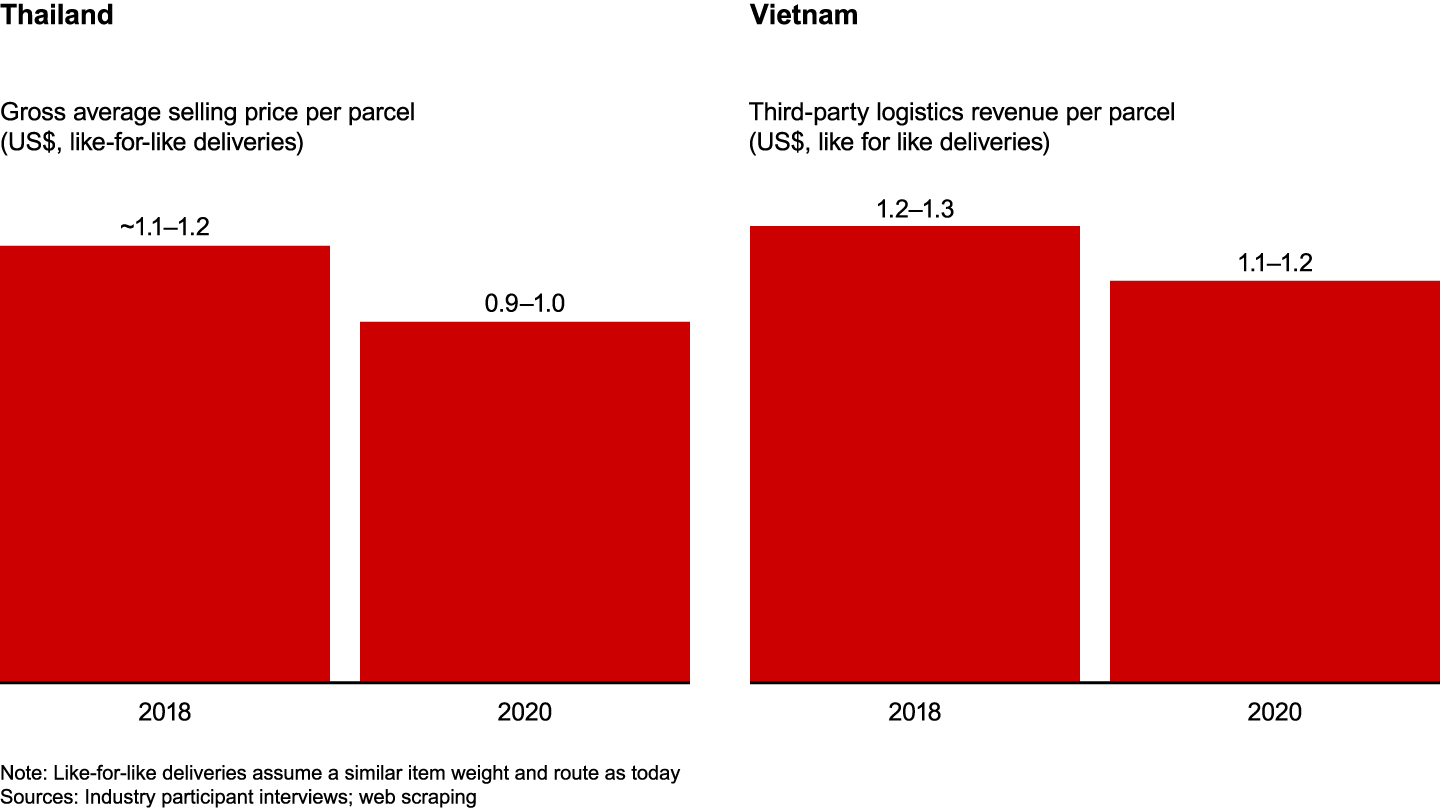

Monk’s Hill-backed Ninja Van is an Singaporean company that uses digital technology to transform last-mile deliveries. Its tools allow users to customize and change parcel delivery timings and locations, while AI is used by drivers to pick the most efficient routes and by shippers to optimize how parcels are packaged.
Having established strong domestic businesses, upstart logistics businesses are rapidly expanding to become regional players. Just as aviation LCCs challenged the common view that ASEAN is “not a region,” so do digitally enhanced logistics companies (see Figure 27).
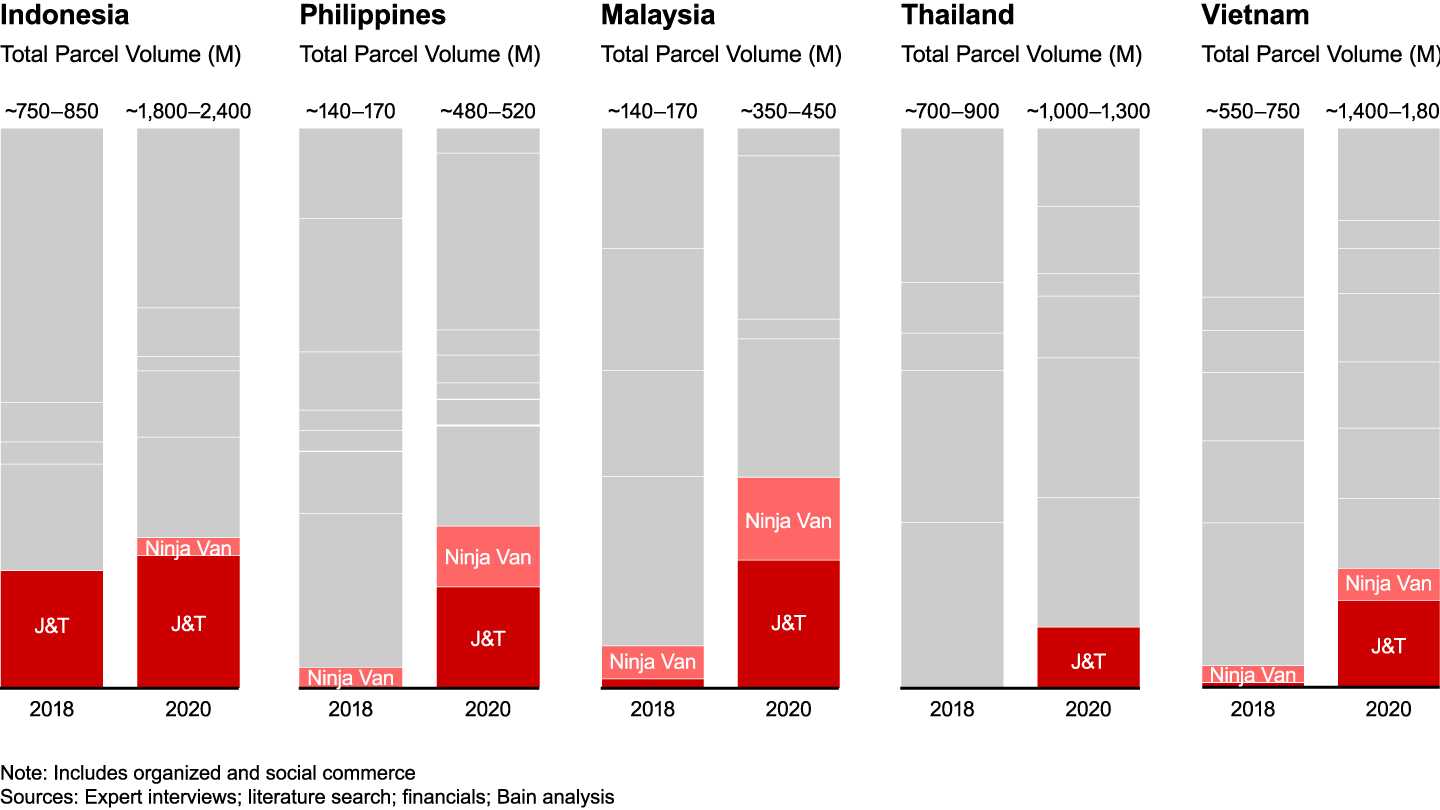

Similar to their approach to LCCs, governments have enabled digital logistics start-ups to compete with their own public-sector companies. Singapore and Thailand, for example, have urged their postal services to partner with insurgents rather than look to the government to protect them. Other governments have supported logistics start-ups by removing regulatory barriers and opening supply chain databases to them.
The same is true of ride-hailing app companies. Although this industry is currently broader than third-party logistics (and its third-party logistics reach is limited to last-mile urban delivery), ride-hailing tech has developed powerful ecosystems that create mutually reinforcing benefits for multiple participants. For example, the holding company GoTo connects the over 100 million users of its e-commerce platform, Tokopedia, to ride-hailing company Gojek, thus integrating retailing with delivery for consumers, small family businesses, and traditional retail chains across Indonesia’s 6,000 populated islands.
Case study 4: Super-apps
If LCCs move people about the region’s islands and mountains, and logistics carries their goods, the rise of digital platform businesses in the form of super-apps is connecting Southeast Asians in the virtual realm.
A super-app is a mobile application that provides multiple services built upon a foundation of payments and transactions processing. While these are “closed loop” systems in which payments can only be made to merchants allowed by a controlling company, they are designed to encompass all the essentials in life. The result is a user-friendly and efficient process where super-apps become embedded in a consumer’s daily activities.
Super-apps create linkages among different verticals within their ecosystem (see Figure 28). Because users don’t need to download a new app for a given function, a super-app turbocharges cross-selling and creates access to new services. This also helps make it more affordable for platform companies in Southeast Asia to operate in multiple markets. Grab, for example, is active in eight Southeast Asia markets. In the physical world, the infrastructure and operating costs would be prohibitive. Grab must still meet local regulations, operational necessities, and market demands, but technology has enabled it to create an identifiable Southeast Asian brand, and its customers expect the same functionality and service when they travel regionally.
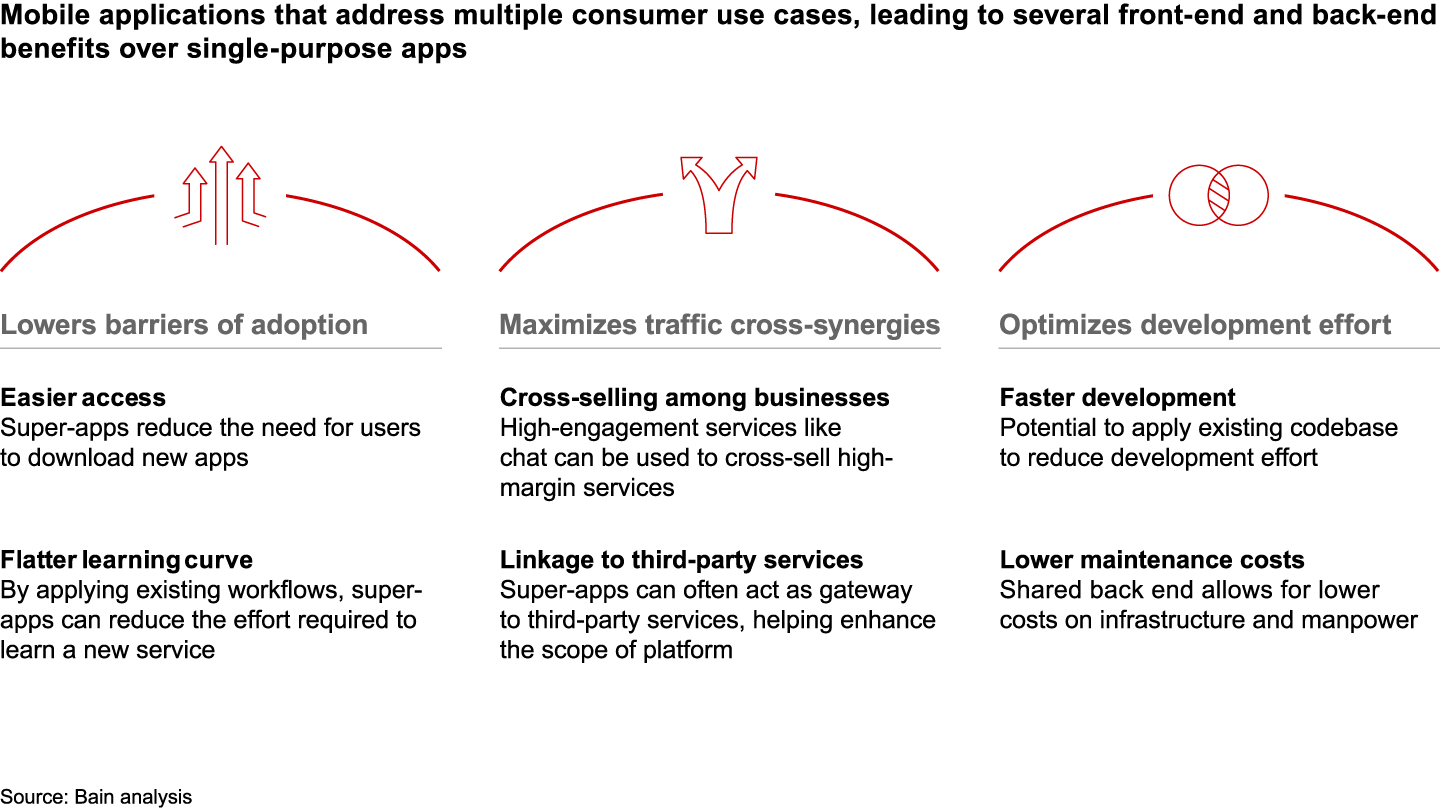

China’s WeChat (owned by Tencent) and Alibaba pioneered the concept of super-apps. WeChat’s initial offerings were gaming and messaging. By adding a payment capability, it was able to branch into travel, shopping, dining, finance, entertainment, healthcare—nearly all aspects of life. Alibaba’s Alipay was likewise the anchor to its apps for small businesses and e-commerce.
Tencent and Alibaba, rivals at home, are strategic shareholders in Southeast Asia’s leading contenders for super-app businesses: Tencent has invested in Sea Group, and both Alibaba and Tencent are shareholders in GoTo (a merger of Alibaba-backed Tokopedia and Tencent-backed Gojek).
Business models vary among Grab, GoTo, and Sea Group. Grab began in ride-hailing, whereas Sea Group’s revenue base comes from mobile games, and Tokopedia (GoTo) began in e-commerce. Today they all have operations in social media, food delivery, finance (including banking licenses), logistics, and other online-to-offline services (see Figure 29).


Although technology start-ups can threaten incumbents in narrow ways, the rise of Southeast Asian super-apps has been welcomed by officialdom. These companies are not displacing incumbents so much as reaching people who previously lacked access to services. They reflect the rapid rise of Internet-surfing consumers, particularly via mobile phones (see Figure 30).
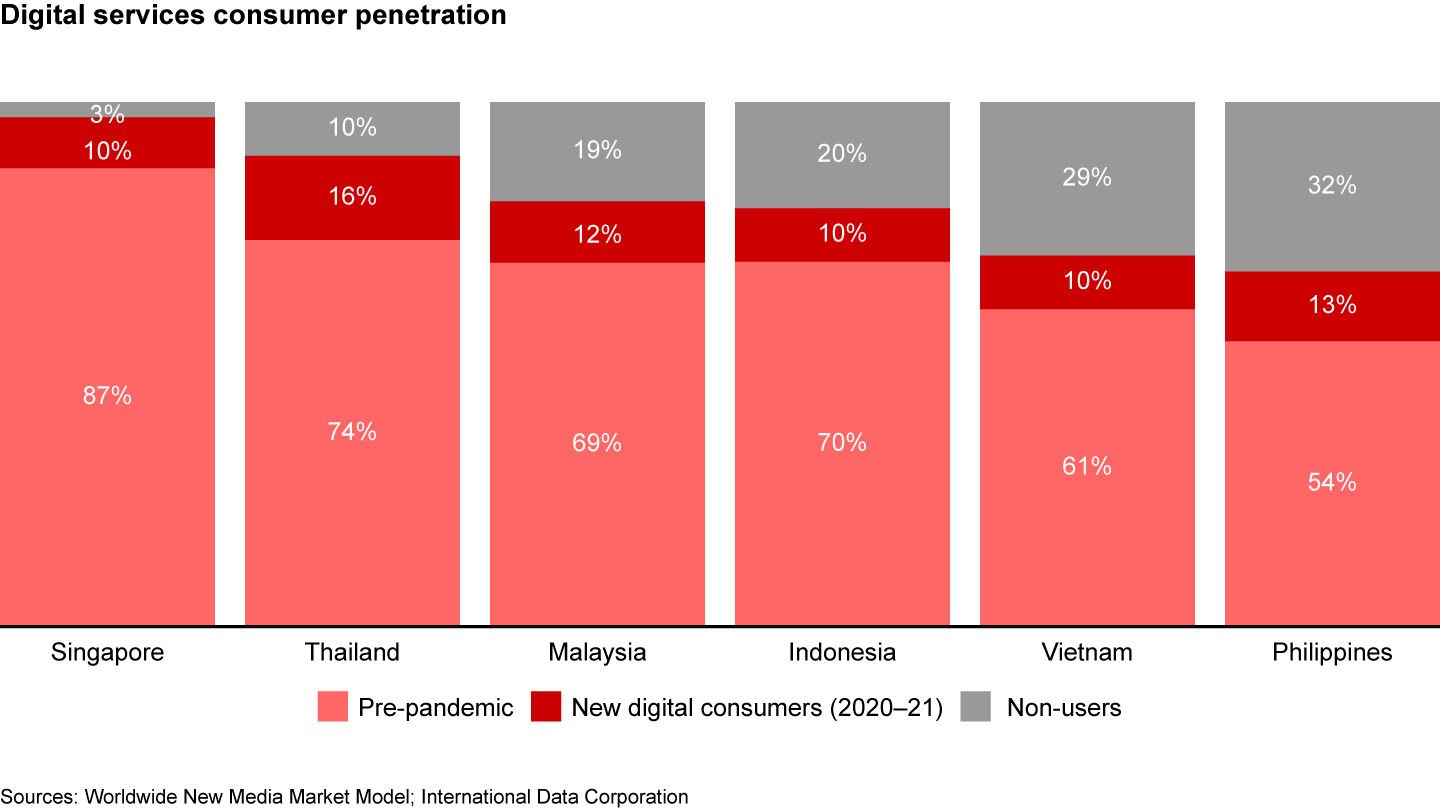

Impact of TEDs on historical and future growth
Southeast Asia’s relatively young population is highly plugged in, thanks to a steady build-out of Internet infrastructure. Advances in electronic payments via the proliferation of mobile wallets and the use of QR codes have allowed consumers and businesses to enter the digital economy (see Figure 31).
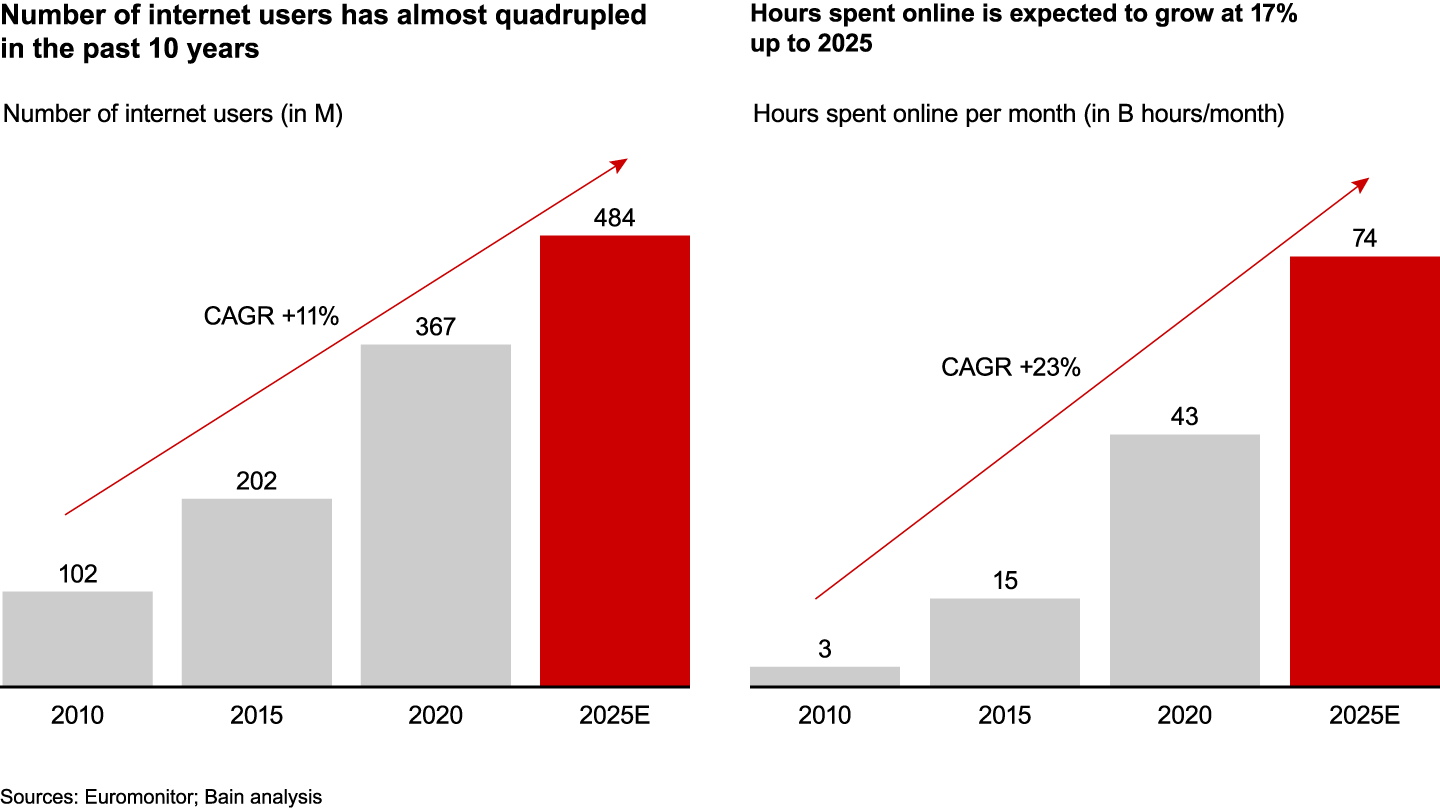

The majority of Southeast Asians now shop online, but e-commerce remains a small portion (usually under 10%) of overall retail sales. While Covid-19 has provided a boost to non-cash forms of payment and e-commerce, the current low penetration rates suggest strong future growth rate potential. This in turn means access to services such as micro-lending, credit, insurance, and investments are poised to grow as well through digital channels—led by the super-apps.
TEDs thrive by using technology to bring efficiency and scale to consumers and business services. One aspect of the digital economy that many investors miss is that growth in technology-enabled services may be faster in developing markets than developed markets because these economies skip the low efficiency “analog phase” and jump to the higher efficiency “digital phase” (also avoiding the need to retrofit)—something we refer to as the “leapfrog effect.” In addition, the low productivity of the services sector in the “analog era” reduced their role in overall growth and increasing inclusiveness.
China’s Internet consumer economy took off in the early 2000s, led by the likes of Alibaba, Baidu, Tencent, and JD. These entrepreneur-led, venture-backed companies copied Silicon Valley business models and applied them to a massive internal market with poor services. Aided by the government’s infrastructure spending, these companies filled the needs of China’s growing middle class without competition from entrenched analog incumbents. In the process, they became Big Tech giants that spawned additional generations of digital companies such as ByteDance and Meituan. No longer copying existing business models, they are now, in many services, the global leaders in service levels, efficiency, and market penetration.
We anticipate Southeast Asia TEDs will follow a “China trajectory” because entrepreneurs can start with existing Western, Chinese, or Korean business models, then adapt them for local conditions. As we noted, the super-app is a Chinese phenomenon, and Southeast Asia’s super-apps all have Chinese investment. The availability of capital is far higher now than when the Chinese firms had their start. And the same paucity of highly competitive analog players means high growth rates are both desirable and sustainable.
Venture capital is flooding in. The region is creating unicorns (privately held companies valued at $1 billion or more) at a record pace. In 2021 alone, the region minted 17 unicorns (see Figure 32).


LCCs, fintech, logistics, and super-apps demonstrate the cumulative effects of TEDs. These opportunities are being created across the region in many industries at a record pace. The digital economy now generates $174 billion of annual gross merchandise value. By 2025, TEDs are anticipated to be the biggest source of new employment in Southeast Asia. Tech-enabled entrepreneurship is creating a positive cycle of wealth creation and demand.
Growth driver #3: Attractive demographics
One advantage of Southeast Asia is the size and growth of its working-age population. In 2022, China’s population tipped into absolute decline. Southeast Asia’s large cohort of children relative to total population ensures a continuing demographic dividend; it will enjoy a youthful population that needs to spend on lifestyle, education, housing, and other needs well into the 2030s (see Figure 33).
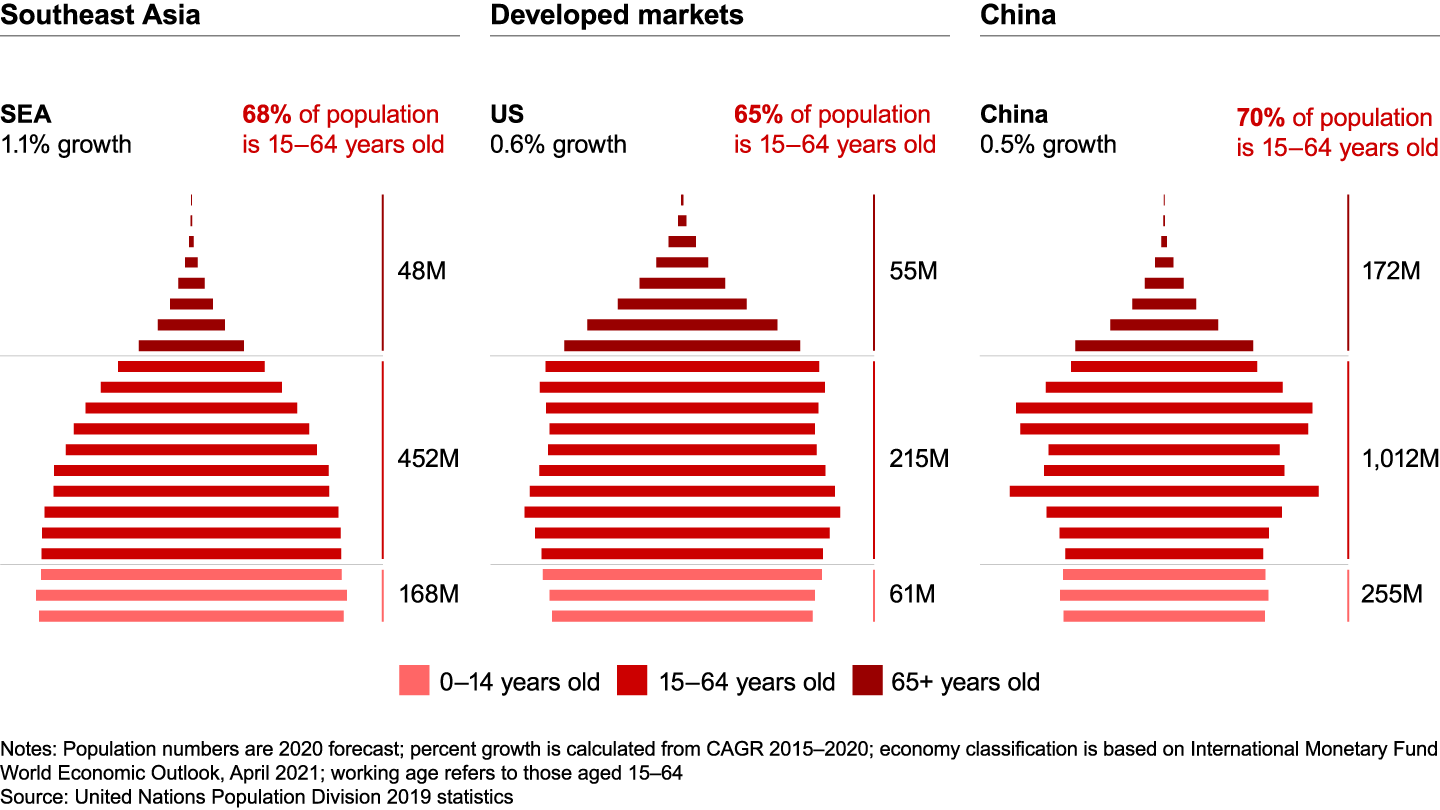

Southeast Asia has seen consumer growth in line with GDP growth—an attractive and sustainable rate (see Figure 34).
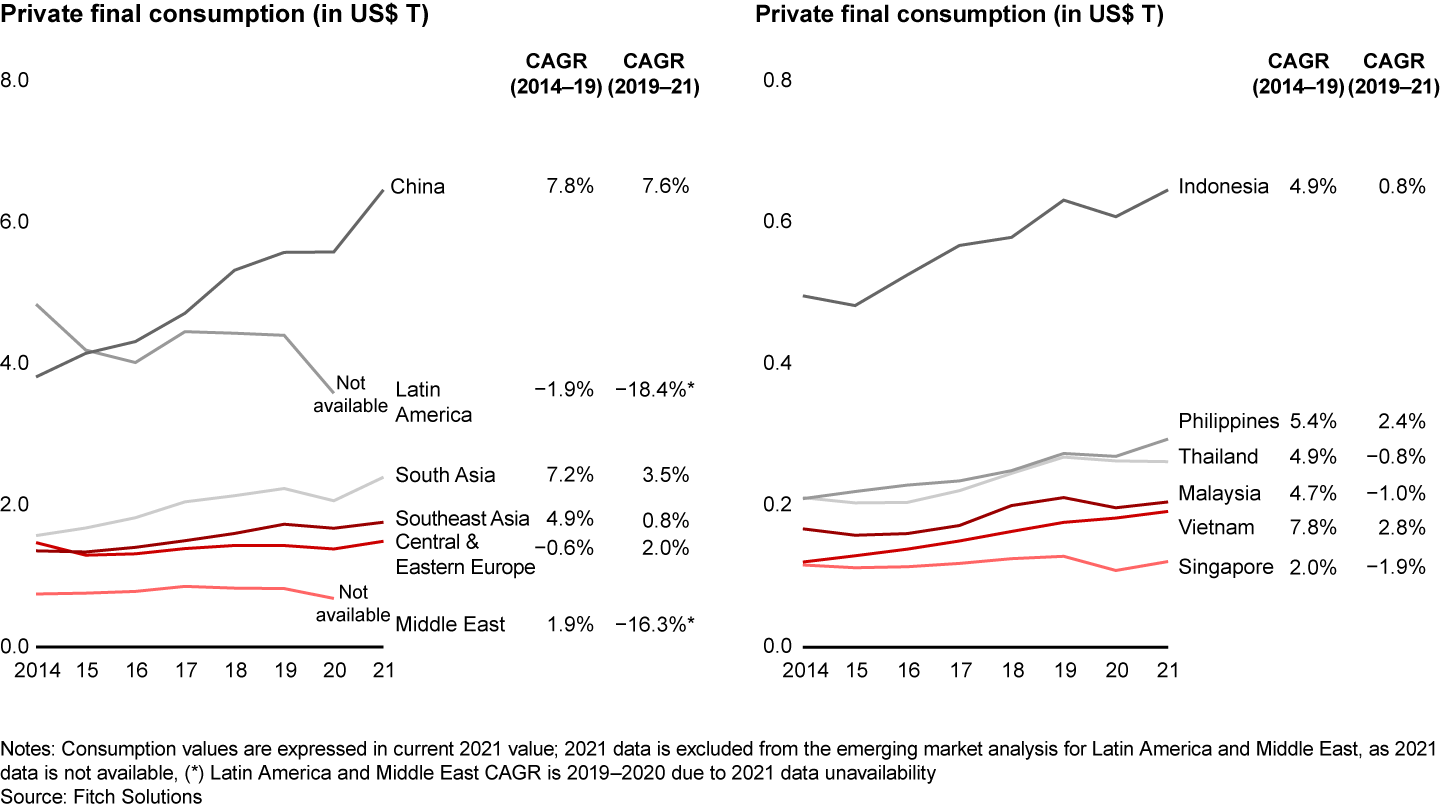

Growth driver #4: Offsetting geopolitical winds
The relatively benign global geopolitical environment of 1990 to 2019 is over. Covid-19; the Russia-Ukraine war; the US-China rivalry; the specter of inflation; and the rise of strongman leaders in India, China, Russia, Turkey, and other countries have led to a far less predictable and business-friendly environment. While concerning, it is important to note that Southeast Asia has traditionally traded peacefully with various “great civilizations”—China, Arabia, Persia, India, Europe—while balancing their competing demands. The exception was the period of colonization by the Europeans: Vietnam (French), Indonesia (Dutch), Malaysia and Singapore (British), and the Philippines (Spanish and to a lesser degree American).
To determine the likelihood of growth in this arena, we scrutinize the following considerations:
Impact of US-China rivalry
Southeast Asia growth could be dampened if ASEAN countries are forced to choose sides in the US-China rivalry. We believe Southeast Asia can and will stay neutral in this contest. Except for the weaker countries like Myanmar, Cambodia, and Laos, the primary Southeast Asian countries benefit from strong relationships with both China and the US (and its allies). More importantly, neither China nor the US has the power to force Southeast Asian countries to choose. Instead, we anticipate an environment where the rival developed countries are forced to compete for access and influence in Southeast Asia.
Shift from globalization to regionalization
Western pundits (e.g., The Economist) have wrung their hands about deglobalization—the trend away from more liberalized trade, capital, and labor flows. Our observation is that the commitment to trade liberalization and trade flows within Asia is increasing (see Figure 35); regional trade within Asia is likely to grow strongly even if trade with the EU and US slows. While there is merit to the view that trade agreements like RCEP, which exclude American and European counterparties, lack enforcement mechanisms, we are cautiously optimistic that the agreements demonstrate Asian commitment to continue expanding trade.
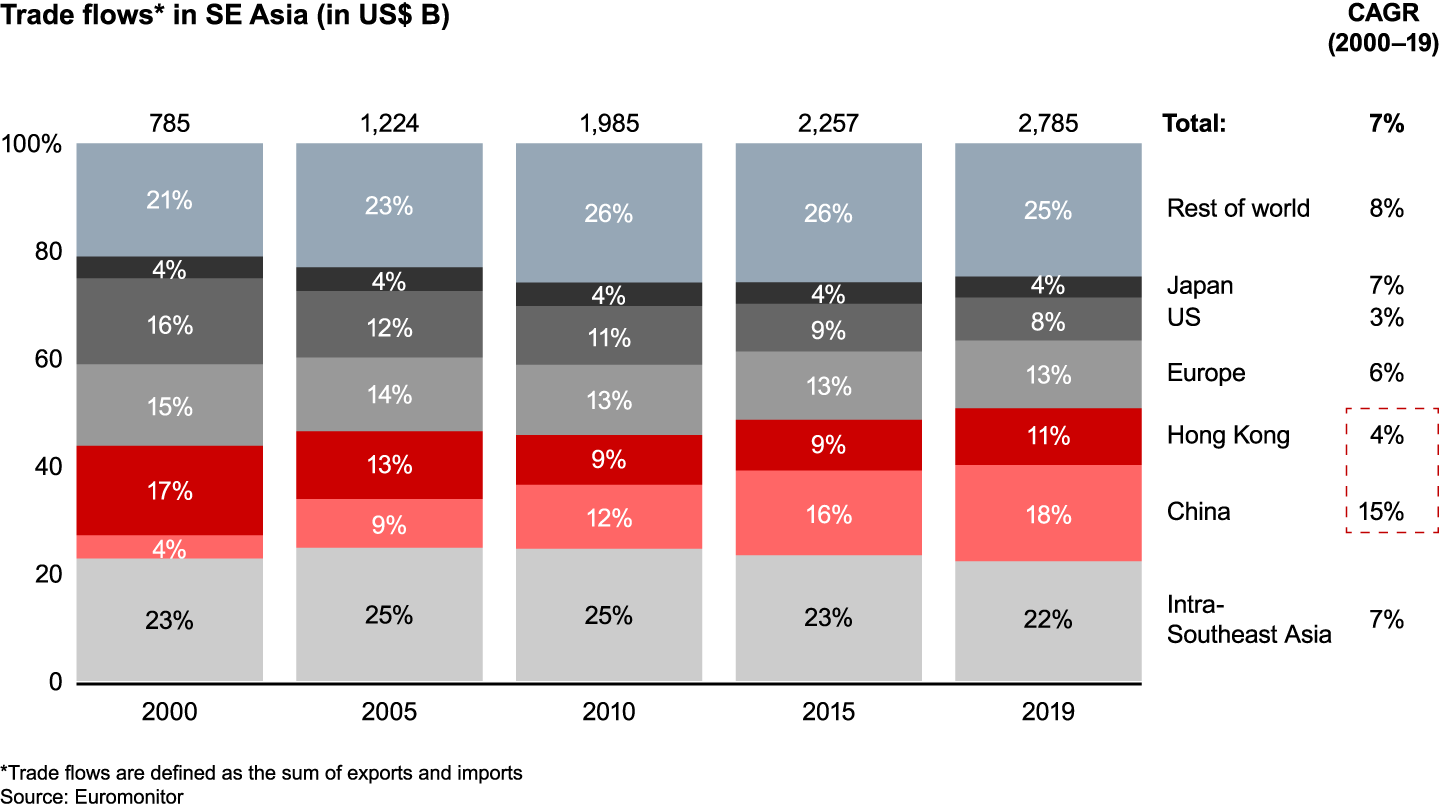

Most of the Southeast Asian trade is intra-Asian (including Japan, Korea, China, and India); these countries have continued liberalizing their trade regimes. In addition, the US is a modest and declining export market for Southeast Asia.
The China dividend
There are two distinct ways that China can positively impact Southeast Asia: as a market for Southeast Asian trade and as a source of FDI as non-Chinese and Chinese companies diversify or shift supply chains away from China.
China (including Hong Kong) has been Southeast Asia’s largest trading partner since 2000. (Note: While China’s share has grown 4.5 times in 20 years, it is better to look at China and Hong Kong combined. With this perspective, the factor reduces to 1.4 times.)
The picture on foreign investment is substantially different from trade. China is only the fourth-largest investor, and growth is not nearly as high as trade growth (see Figure 36). We believe this reflects the intensive scrutiny many Chinese firms face when undertaking foreign investments.


Analysts have cited many reasons for global investment to shift from China to other countries, including Southeast Asia. The most cited is a declining workforce (see Figure 37).
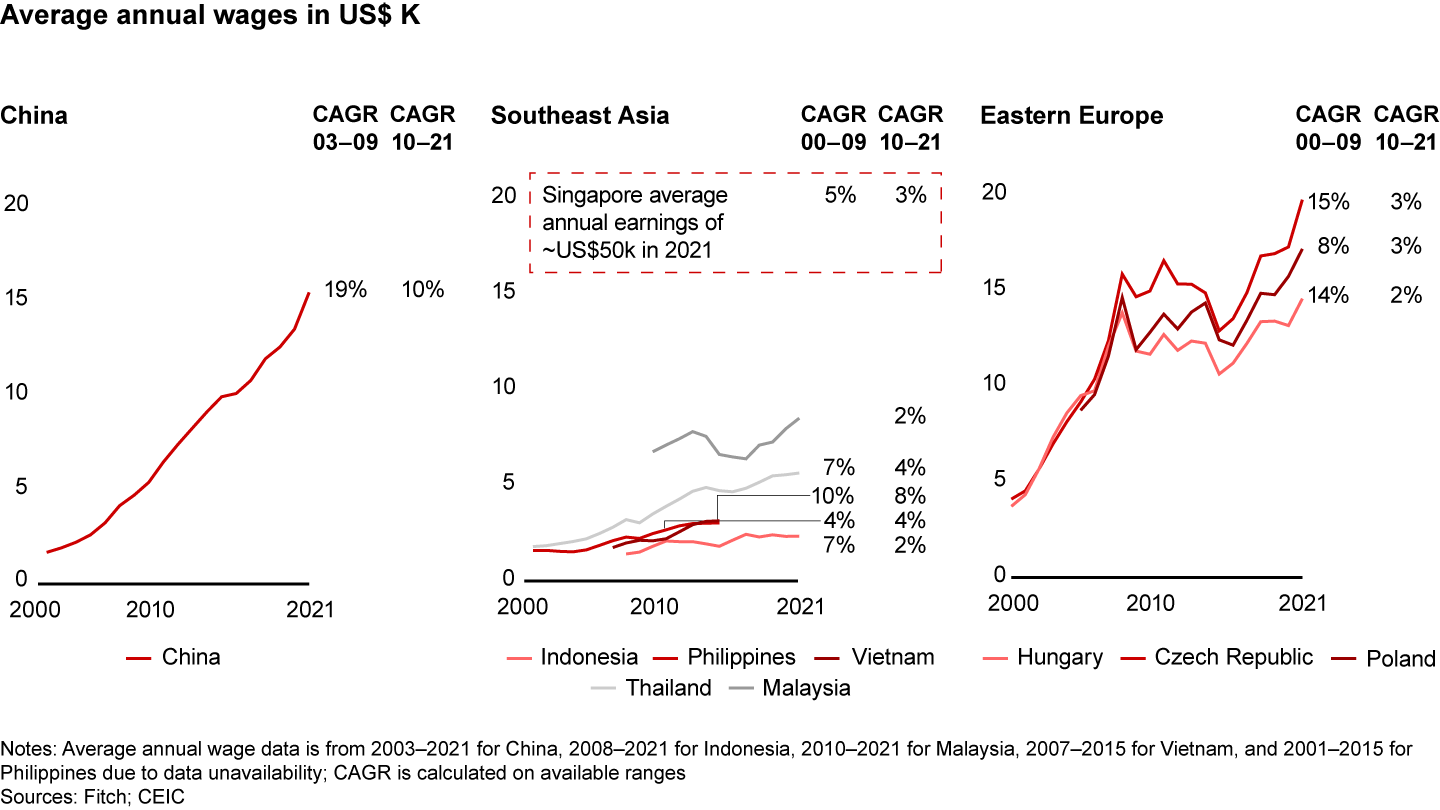

However, offsetting the consensus view of the “China dividend” is the reality that China is a fierce competitor. It has a massive, relatively unified, fast-growing consumer market; highly productive industries leveraging deep talent bases; established infrastructure; a high savings rate; and a strong position and R&D spend in many emerging industries.
While Southeast Asia may get some good investments in sectors that are no longer competitive in China, that will not be a source of above-market growth. China’s own direct investment into Southeast Asia is relatively flat and below that of Europe and Japan. China’s demographic challenges are real, but China’s historical productivity growth and strong position in automation will delay the impact of this factor in the 2020s.
Singapore benefits from tailwinds
Singapore has some of the most exciting tailwinds of any Southeast Asian country. With up to 40% of Hong Kong residents considering emigration, Singapore is attracting both Western expatriates and Hong Kong citizens. This movement comes as the “one-country, two-systems” formula for governing Hong Kong since its 1997 handover has come under question, and as Hong Kong has emulated parts of mainland China’s isolating “Zero Covid” policies.
Meanwhile, Beijing’s significant intervention into the soft tech sector in China has resulted in several Chinese companies (e.g., ByteDance, Alibaba) shifting resources and executives to Singapore. Finally, Singapore has played a major role in the infrastructure for Southeast Asia’s own TED boom: legal, venture capital, key services, data centers, etc.
Global instability and negative geopolitical factors
At the time of this writing, the Russia-Ukraine war, the continued impact of Covid-19, dramatically higher commodity costs, climate change, and the US-China rivalry are major challenges that were not relevant or were considered manageable 10 years ago. While every challenge brings opportunity, overall, the next decade will be a more fragile, less stable investing environment, with many of the consequences borne by the poor and emerging middle classes of the developing world, including Southeast Asia.
Southeast Asian governments’ lack of “serious intent” on climate change and other environmental protections may be penalized by investors
The consensus view is that, within Southeast Asia, only Vietnam and Singapore are matching climate commitments with clear policies and resourced undertakings. From deforestation, to poor progress on renewables, to limited efforts to decarbonize important industries like cement, steel, agriculture, mining, and transportation, there is insufficient effort to join the global shift in priorities. Investors may limit investment in key industries like plantations, mining, steel, and cement.
Political instability and corruption
The last decade has seen steps backward in Malaysia (1MDB), Thailand (a military coup), and Myanmar (a military coup and civil war). Perhaps as a result of the political instability, these countries have made fewer positive steps toward pro-growth policies. In addition, we have concerns about populist measures to constrain exports to stem local price inflation (e.g., Indonesia with palm oil or Malaysia with poultry). Despite being temporary, these policies undermine investor confidence in transparent and stable “rules.”
Relative to the OECD countries, these concerns are warranted, but relative to other developing countries, the region is relatively stable and well governed.
Conclusion: Growth projections
Southeast Asia’s per capita income has been growing, but with appropriate policy measures we believe Southeast Asia could return to leading emerging markets growth.
In general, we see four broad drivers of growth in Southeast Asia:
- traditional drivers that require progressive government policies;
- the insurgent TED economy, which can benefit from government support but is likely to charge ahead unless constrained;
- demographics; and
- global geopolitics.
Our approach to forecasting is to start with the 30-year GDP/capita growth trend and ask if there is any reason to believe the performance in the next decade will be better or worse. We cluster our conclusions accordingly:
- Vietnam (slightly better than trend)
- Indonesia, Malaysia and Singapore (roughly on trend)
- Thailand and Philippines (slightly below trend)
Given that we are more pessimistic on both China and the OECD countries, this is a relatively positive outlook.
In terms of a more optimistic scenario, one would need to believe four things:
- The current global stresses (Covid-19, global inflation, the Russia-Ukraine-war, the potential for US-China conflict) are resolved expeditiously.
- Southeast Asia renews a commitment to growth-oriented policies.
- We underestimate the “China dividend.”
- Funding for the entrepreneurial sector returns to high levels.
In terms of a more pessimistic scenario, the opposite would be true:
- The current global “stresses” (Covid-19, global inflation, the Russia-Ukraine war, the potential for US-China conflict) are not resolved. Economic growth is impacted by the threat of conflict over Taiwan.
- Southeast Asia engages in more “populist” policies that inhibit growth (e.g., high minimum wages; excessive “social burdens” placed on business; excessive anti-trade, capital flow, or labor migration policies; government spending shifts to subsidies and transfers versus infrastructure and education). See, for example, the rapid demise of Sri Lanka as a template.
- We overestimate the “China dividend.”
- Funding for the entrepreneurial sector is significantly disrupted.
Between those extremes, we are optimistic in our base case, which sees the region return to its pre-pandemic per capita GDP growth trajectory of 3.2%. In this scenario, TEDs will benefit from, and continue to support, consumption growth by both the rising middle classes as well as the bottom half of the region’s population. More countries in Southeast Asia will follow Vietnam’s example and pursue the “China dividend” as global corporations (including Chinese companies) diversify supply chains.
Overall, we believe the base case is the scenario to bet on. Southeast Asian countries have proven relatively stable over the years, and governments have generally been more pro-growth and fiscally conservative than their peers in Latin America, Africa, or South Asia. We are more optimistic than conventional wisdom on the prospects for strong, organic growth oriented toward the domestic market. We are more pessimistic than conventional wisdom on the potential to win a significant “China dividend” given China’s continued strength across every growth driver that we assess as important. TEDs, as digital intraregional players, bring a new driver of consumer growth that will make Southeast Asia a moderately more cohesive investment class rather than a collective of divergent country narratives.
The author would like to thank Bain’s Stephanie Tsjim, Chanikarn Wongtada, and Tanruk Chaivirunjaroen for their contributions to this report. Peng T. Ong, Gita Wirjawan and George Yeo, members of the Monk's Hill Angsana Council, contributed heavily to this report.
Appendix 1
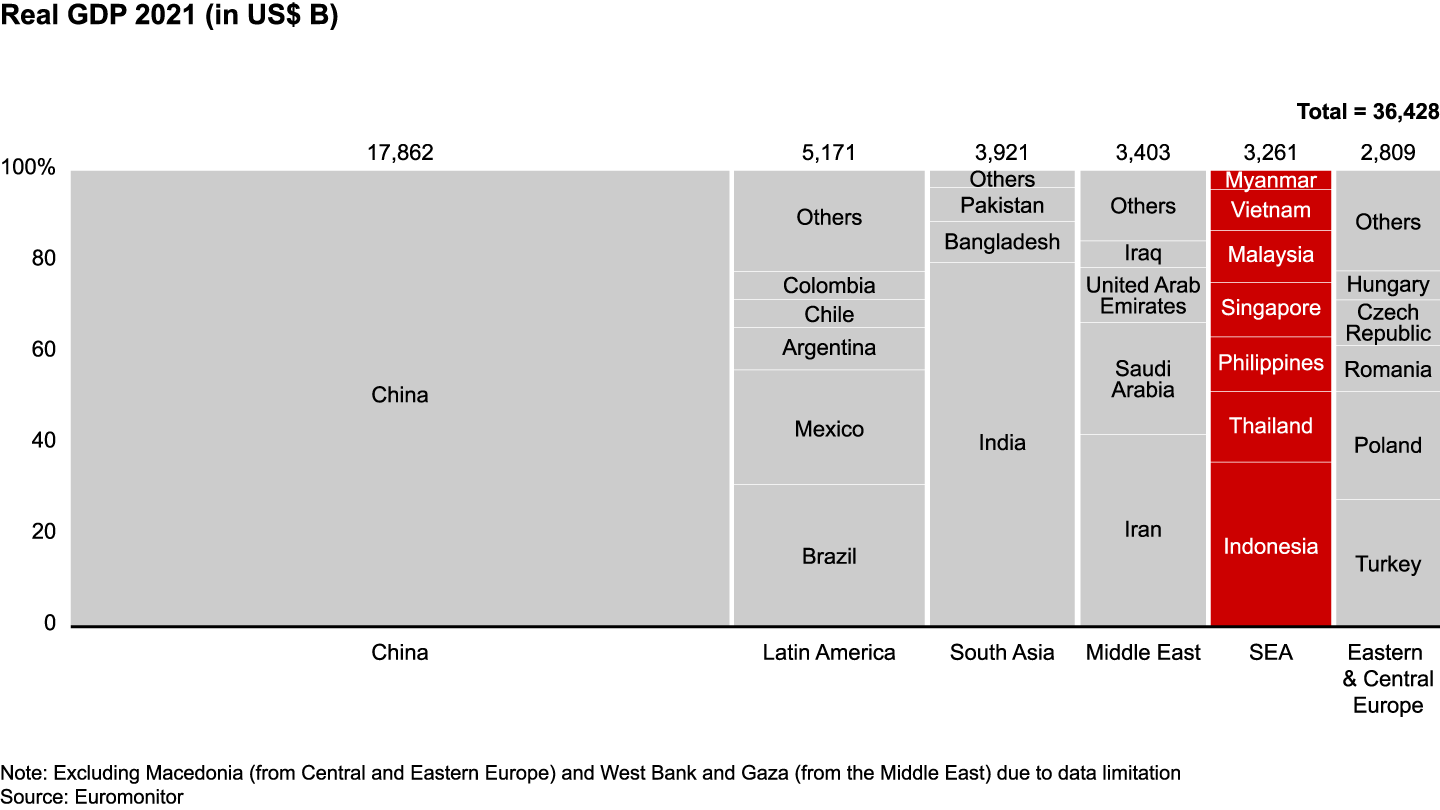

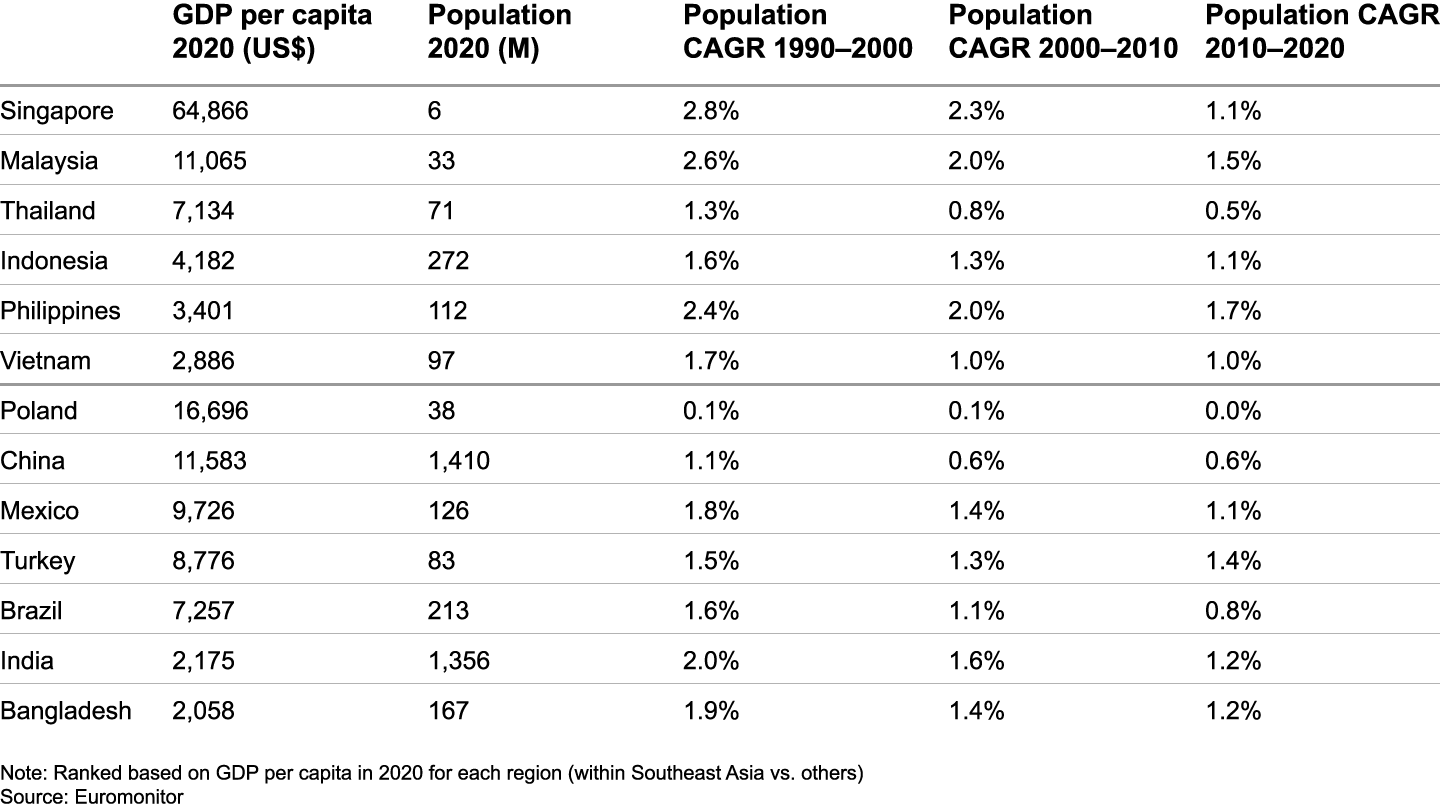



Appendix 2
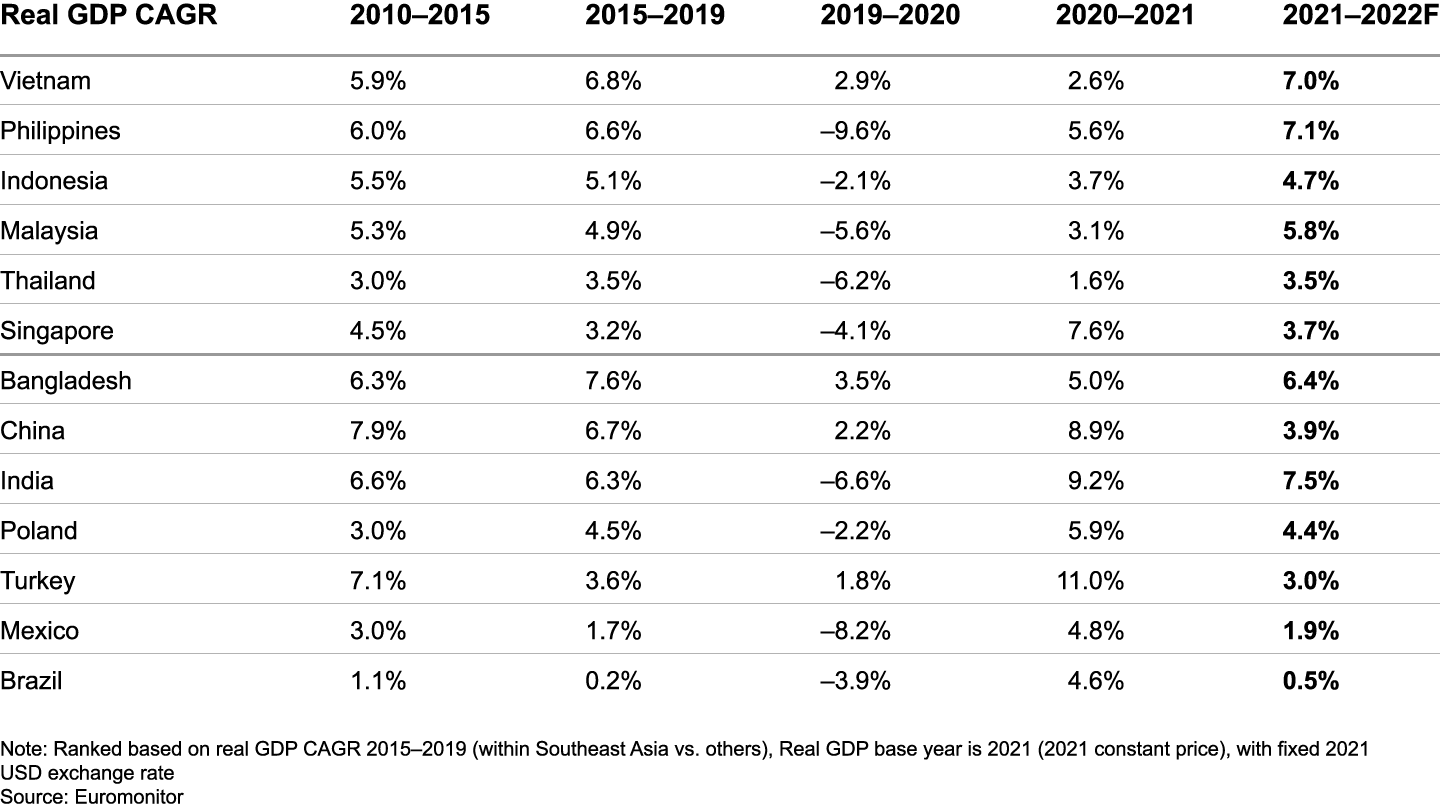

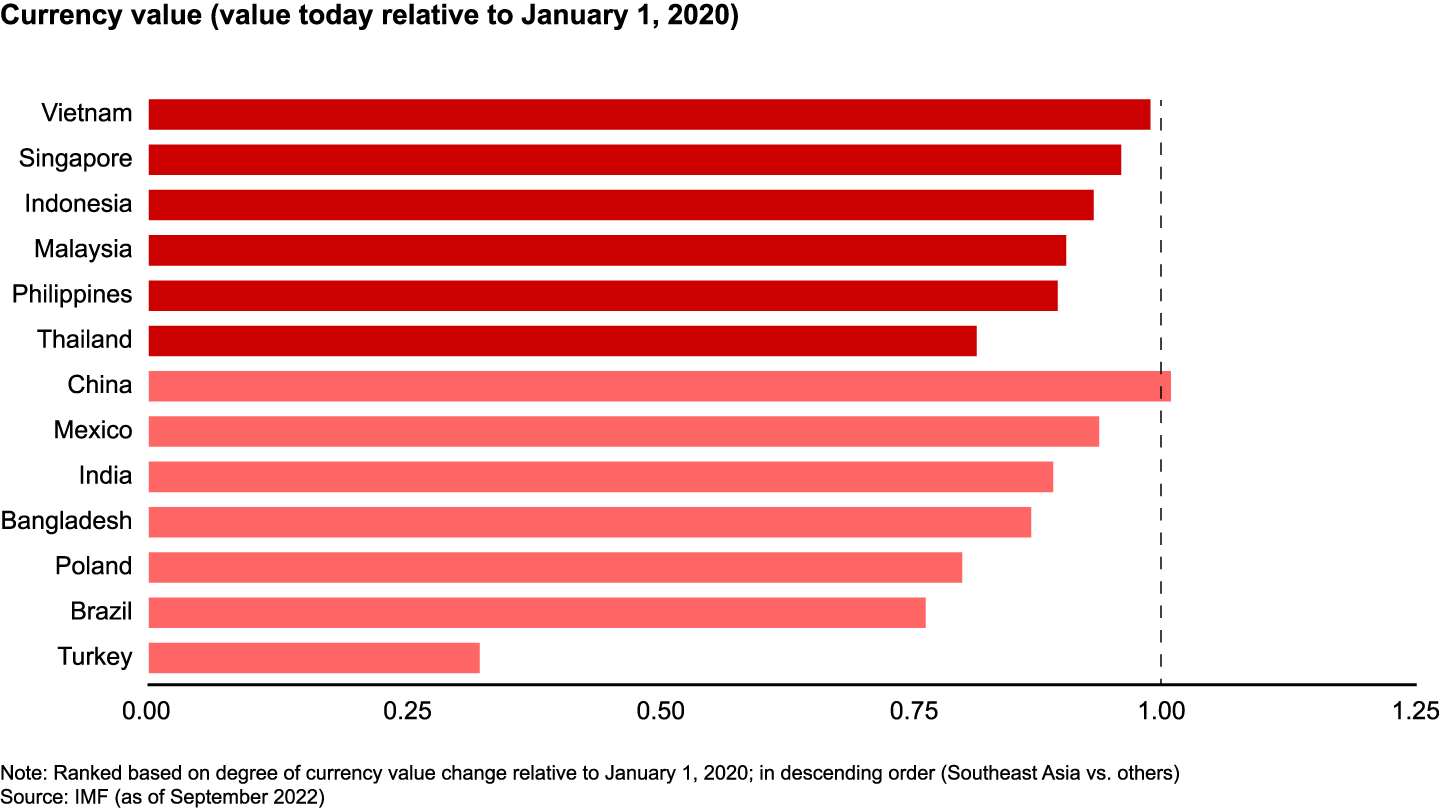

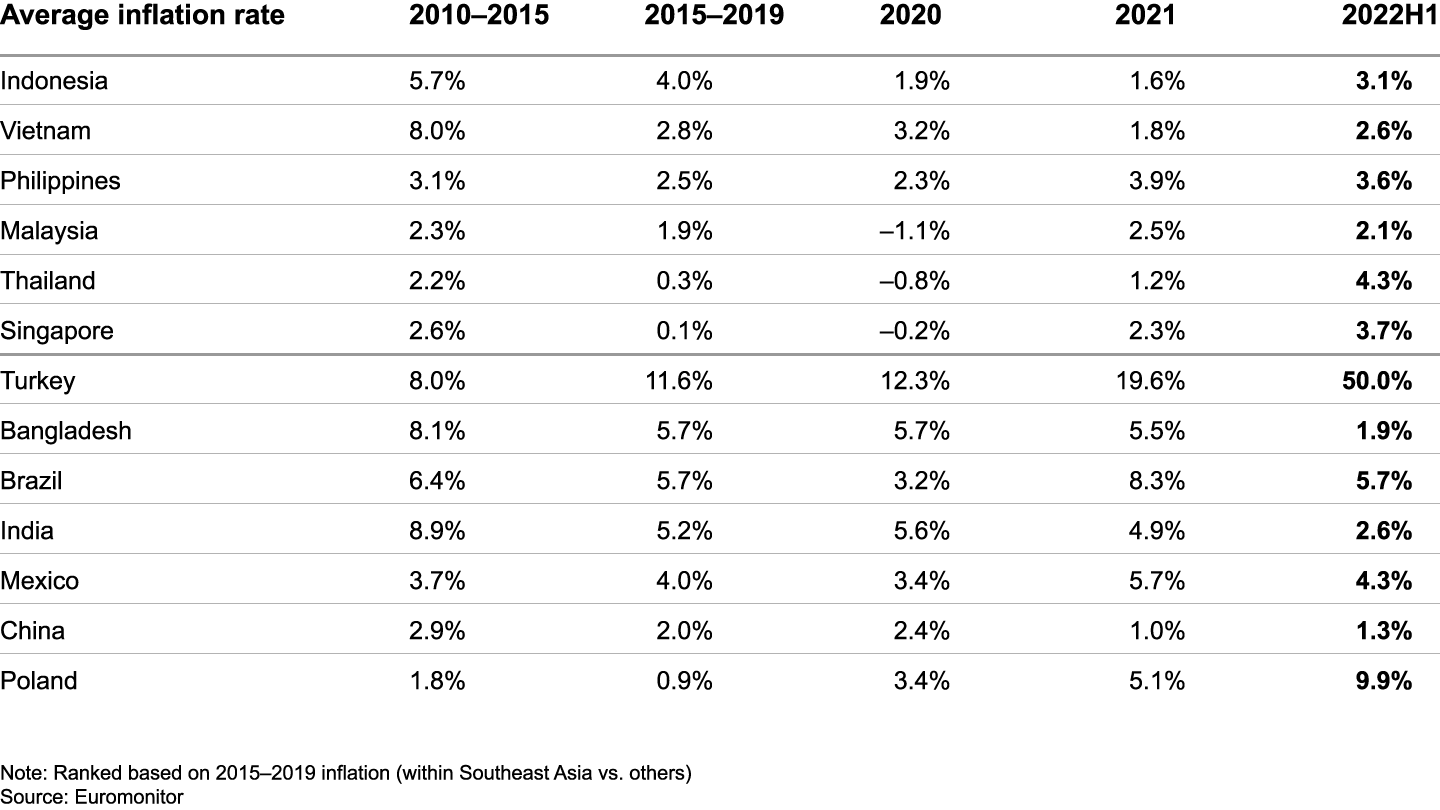

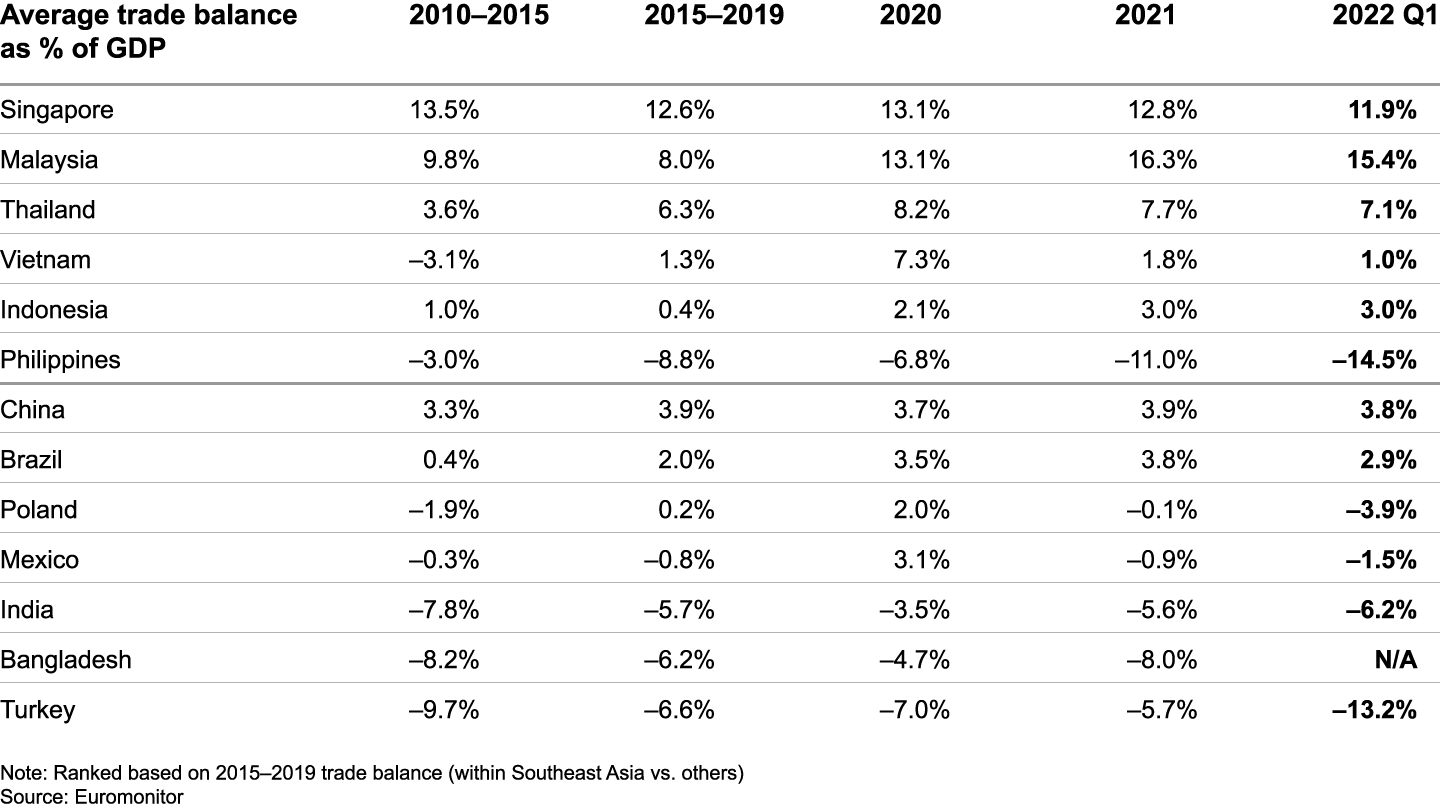

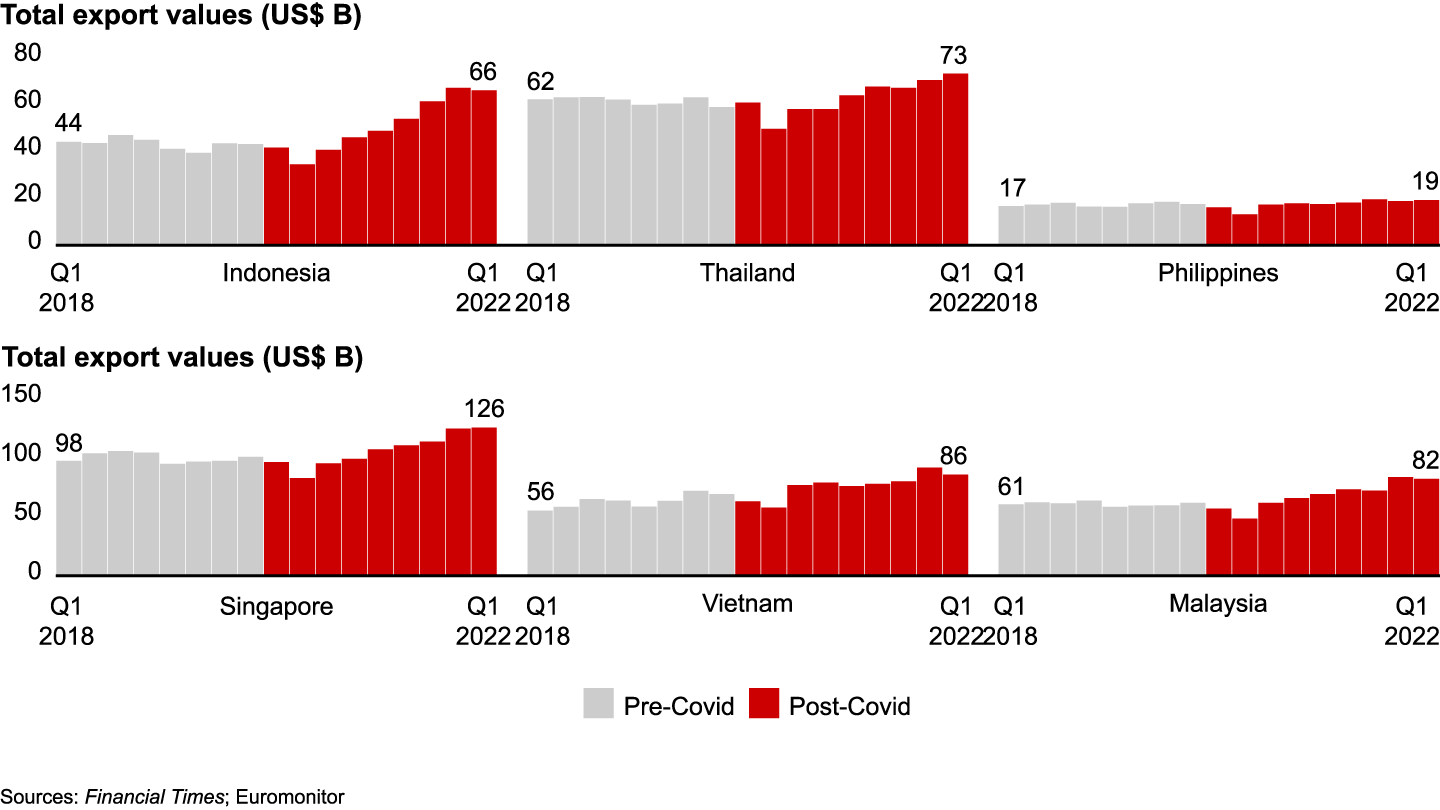

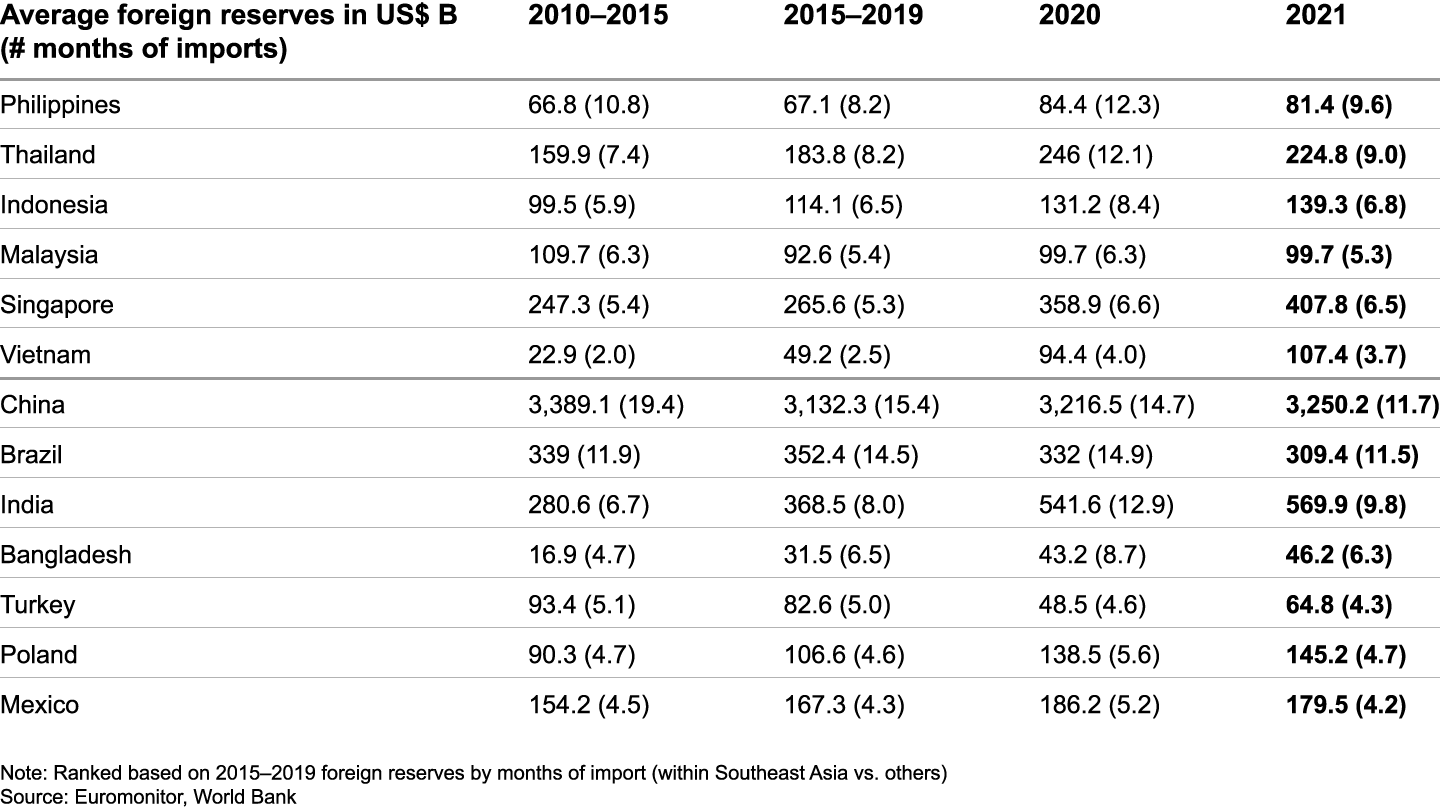

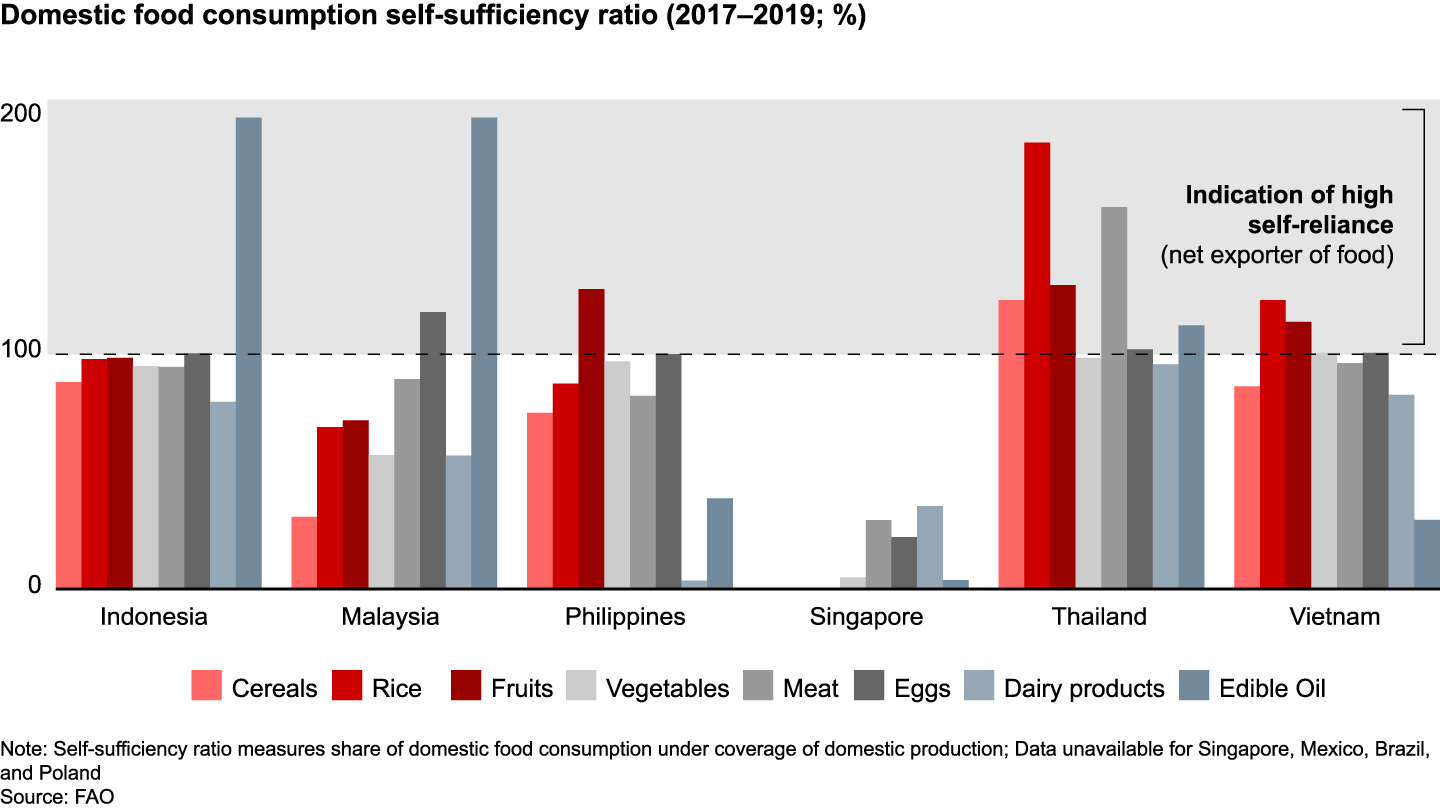

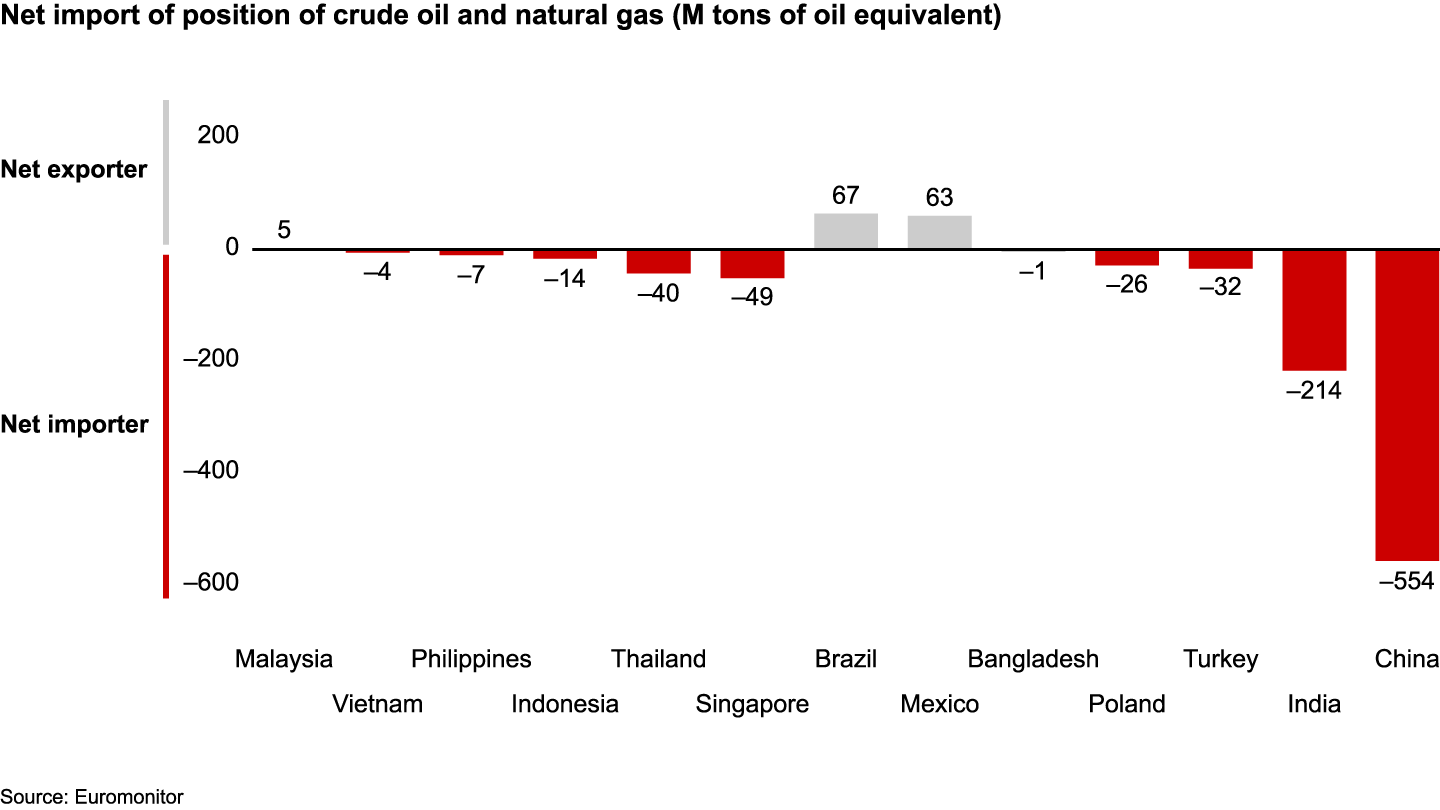


About Angsana Council
Founded in 2022 by Monk’s Hill Ventures, the Angsana Council is a non-profit group that is committed to increasing the growth and prosperity of Southeast Asian businesses and economies. The Angsana Council is led by members with a track record in accelerating economic and societal change in Southeast Asia. Our mission is to shift the world’s attention to the thriving region through dialogues with entrepreneurs, policymakers, and change agents. We advocate that steady historical growth can be achieved by raising investment levels, promoting entrepreneurial activity, supporting growth-friendly policies, and strengthening institutions. A cornerstone of the Angsana Council’s work is integrated insights from deep business, government, and social experience and access to comprehensive quantitative and qualitative research. The Angsana Council is financed by Monk’s Hill Ventures, a venture capital firm investing in earlystage tech companies, primarily Pre Series-A, and Series A, in Southeast Asia. Backed by institutional investors and family offices worldwide, Monk’s Hill Ventures works with great entrepreneurs to use technology to improve the lives of millions of people in the region. The Angsana Council will collaborate closely with partners who share our desire to positively impact the markets in which we operate.